#It's the only was I can describe this version of Watts
Explore tagged Tumblr posts
Text
So how did we get from this

Dedicated to his Worshippers, George Frederic Watt (1817-1904)
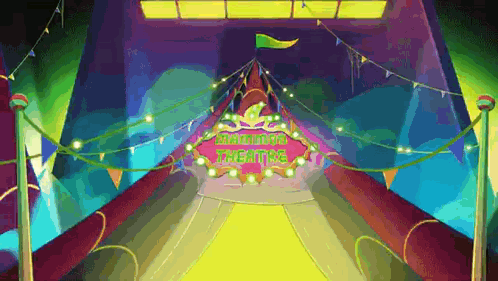
To this?
A brief history of Mammon
Addendum Because We Can't Have Nice Things: this essay is in no way meant to be a "critique", criticism, or personal attack against Helluva Boss/Hazbin Hotel/Vivziepop as I am, in fact, a big fan of all three! I actually loved the newest episode and Mammon as a character. Seeing him in motion, I think he looks damned near perfect as a modern take on the King of Greed. I wrote this ONLY for educational purposes.
Mammon is a Chaldee (the Semantic language of ancient Chaldeans, the people of a small Mesopotamian country who were later absorbed by the Babylonians) or Syriac word meaning "wealth" or "riches".
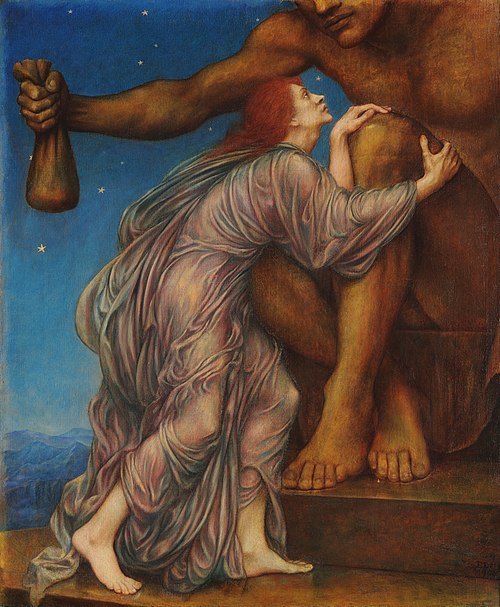
The Worship of Mammon, Evelyn De Morgan (1909)
He is best remembered from the Sermon on the Mount from Mathew 6: 24 (King James version): “No man can serve two masters: for either he will hate the one, and love the other; or else he will hold to the one, and despise the other. Ye cannot serve God and mammon.”
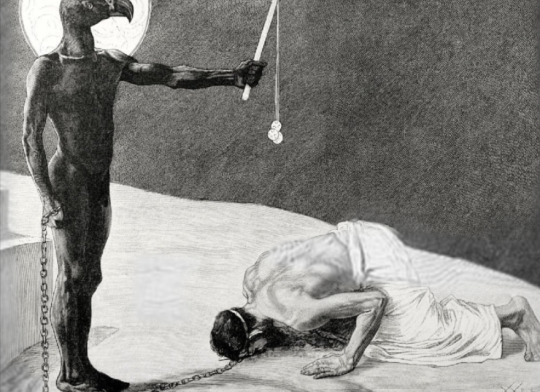
Some scholars believe Mammon might have been loosely based on Dīs Pater, originally a Roman God of mineral wealth and fertile lands who was later merged with the chthonic deities of the underworld Pluto and Orcus (because minerals come from underground). Pluto was depicted in the Divine Comedy as "wolflike demon of wealth"; wolves in the medieval times were symbols of greed. Others think he might have been an ancient Syrian god, though no trace of his cult or temples exists.

Mammon transformed over time from an abstract concept to major demon. This is thanks to later philosophers and theologians such as Saint Gregory of Nyssa, a third century Byzantine scholar, Archbishop of Constantinople John Chrysostom, and Peter Lombard, bishop of Paris from 1159 to 1160. His book of Four Books of Sentences (Sententiarum libri IV) was the standard theological text of the Middle Ages.
Mammon was assigned the sin of greed according to the Peter Binsfield classification of demons.
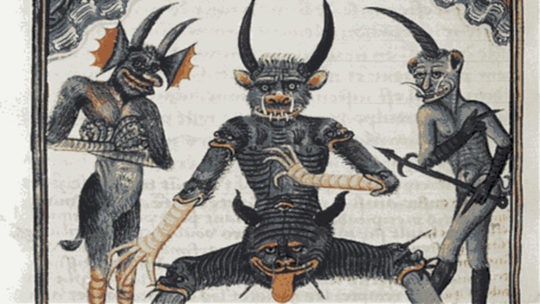
John Milton of Paradise Lost fame imaged him as a fallen angel. He is described as being stooped over (literally the "least erected" of Lucifer's demonic host) because he always has his eyes downward looking for gold and would rather use Hell's resources to finance his lavish lifestyle than wage war against Heaven.

In Edmund Spenser's 16th long poem, The Faerie Queene, Mammon is a “uncouth, salvage, and uncivile wight” who sets up his cave of riches right next to the entrance to the underworld. Subtle, huh? He tries to tempt Sir Guyon, the protagonist of Book II, with all his fabulous wealth, arguing that he could use it for good. (This is a religious-moral-political allegory about temperance, so you can guess how well that went.) He shows up again in Jacques de Plancy's Dictionnaire Infernal as Hell's ambassador to England. Yes, really.
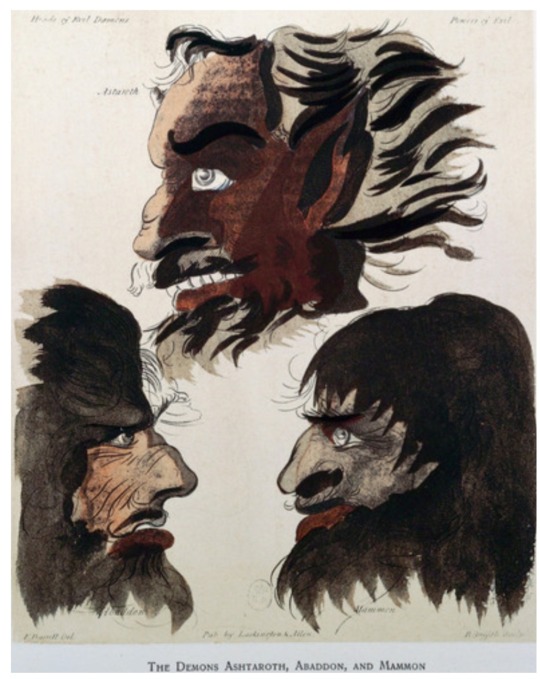
Just like in Biblical times, reformists used Mammon as a symbol of exploitation and unfettered capitalism during the industrial age.

Fun fact: Mr. Burns lives at the corner of Croesus and Mammon street.
So how does Vivziepop's version compare to the historical Mammon? I dunno, he hasn't appeared in the show yet. It's not my favorite design, but I like the fact that half the fandom was expecting him to be the Big Bad of Helluva Boss, and he's a just big heckin' chonk who sort of looks like a demented Dr. Suess character crossed with a demonic air freshener. It's a silly design for a silly dude, but he could be more dangerous than he looks...
86 notes
·
View notes
Text
Okay so I wanted to talk more about the poll listing Hero as a villain song and how little sense it makes to me. Admittedly Les Poissons also doesn't make a ton of sense as Louis is more of an antagonist not a villain but at least Sebastian sees him as a villain so it kind of works. But Hero is called well Hero for a reason, and classifying it as a villain song is strange to put it mildly.
The first lines from Hero that most fans heard where:
I would die Without regret, I'd offer up my life With zero reservations I would fly Into the sun, if that would keep our dream alive
I say most fans heard as those are the lines the song starts on in R/WBY during the Gravity fight. The first lines of the song are:
Take my hand I'm here to protect you Nothing will stop me Understand There's no sacrifice that I won't make I'll risk it all to keep you safe Trust me to be strong I'll be your hero, just hold on
Now regardless of which lines a fan heard first, both convey that James is willing to die to protect people. He is willing to sacrifice himself to protect people and keep them safe. That is not the mindset of a villain. It doesn't meet any criteria for a villain song. TVtropes describes a villain song as: "The Villain Song is an over-the-top, gloating cackle about their Evil Plan, philosophy of life, or why they do what they do" They also mention a villain song can be someone else singing about the villain and what they've done like Cruella Deville or it can be a villain trying to trick or manipulate someone to do what they want like Friends on the Other Side or Poor Unfortunate Souls.
Now lets take a look at every version of villain songs. Hero doesn't discuss some evil plan or really any plan. It's about James's desire to protect people, which definitely isn't villainous. James isn't singing it so it's not him talking about his philosophy and their is no mention about why he does what he does, only a desire to help people. No one else is even singing the song so its not like Cruella Deville and again their is no villainous deeds being discussed so even if someone else was singing about it, it doesn't work as a villain song.
Now some people might argue that it is James tying to manipulate people but again, James is not singing it, so he can't be manipulating someone when he is silently fighting a known terrorist and trying to stop him form destroying Amity Tower and killing everyone. And again, even if he was singing it, it doesn't make any sense to be "manipulating" Watts as Watts works for Salem and is helping end the world. He is not a hero in any sense so the argument James is manipulating a villain because he is a villain despite his only goal at the moment being to stop a terrorist makes no sense.
So, the song doesn't match any sort of definition of what a villain song is. Furthermore, the lyrics are not those of a villain. RW/BY songs are said to be the characters own inner thoughts. A villain would not think about being willing to die for someone or a greater goal. They would not think about offering comfort and kindness.
Now this goes more into head cannon territory but for me parts of Hero like:
Deliver you from harm Shelter in my arms The fear will surely fade Know right now the plan I made will guide us home We'll survive this storm
or: Hope's not gone, just hold on
Are words James wishes might be said to him. Just look a t how happy he is when he's told Ozpin is back and in Atlas.
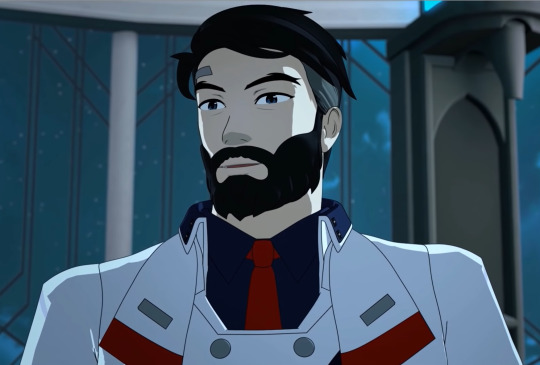
Vs how crushed he is when he finds out Ozpin is gone again.

For me personally this always read as someone who is tired but carrying the weight of the world on his shoulders because their isn't anyone else who can carry it. He has to but hopes their is someone who can help him, but when he realizes that isn't the case he continues carrying the burden and continues to stand tall and offer hope and shelter to people the best he can.
Back from head cannon territory, I want to focus on this line here: Hope's not gone, just hold on
Offering assurances that the war is not lost, that they just need to keep holding on and not lose hope. Those are not the inner thoughts of a villain. They're the inner thoughts of a Hero. The very name of the song.
Even if we could convince ourselves that Hero has lyrics of a villain song. James is not yet a villain when the song plays (yet is used vey loosely here as volume 8 is just. So bad. He shouldn't have been a villain ever but that's another post). He is actively fighting Watts, someone who works for Salem, someone who is trying to end the world. He is actively working to keep people alive when this song plays. Trying to apply Hero as a villain song to an arc that happens in a volume the song never plays in makes little sense.
The writers themselves said the ending of volume 7 was supposed to be a trolley problem with no clear right answer. So calling him a villain in volume 7 also just doesn't work based on the writers own words. But again, even if the writers now say James was clearly the villain at the end of volume 7, that doesn't fix the issue of James clearly being the hero in the Gravity fight where the song Hero plays.
I don't know how else to put this, but saying Hero is a villain song is so laughably wrong it's crazy I have to discuss this at all.
#rwde#james ironwood#ironwood protection squad#pro james ironwood#pro ironwood#general ironwood#general dadmiral#dadmiral ironwood
45 notes
·
View notes
Note
What's everyone in your BATMM AU's favorite food?

Great question! (Finally someone ask me about their favorite stuff) I also included my OCs and put the gang's least favorite food as well.
(note: some are based on what I like and dislike)
Flarelyn Family AU:
★ Blaze just loves chocolate truffles but only gets to eat it once because it's such an special treat for him to eat as she may not self control themselves and hates spicy food (man can eat it whatever he wants but he's not a fan of it for some reason.)
★ Crusher really fw seafood especially that has soup on it (specifically sushi). Also Crusher also fw with spicy noodles.
Crusher doesn't like other spicy food in general and pickles.
★ Fiar loves the Mac-And-Cheese and Strawberry Lemonade combo. She made this combo by herself when she was making herself strawberry lemonade while Crusher was making Mac And Cheese for her.
Fiar hates spicy food, banana and avocado. She will only eat the banana if it is a banana split or covered in chocolate and sprinkles.
(don't ask me why the FF hates spicy food, they're an sweet tooth family)
★ Pickle is very much obviously enough, usually doesn't have a least favorite other than non-edible food.
★ Watts fw Ube Grilled Cheese! (Watts just loves ube flavored food) and she also likes Siopao (especially the toasted one! That sh🫧t is really good. /Gen)
Watts doesn't like spaghetti that much anymore (specifically the Filipino one) because of how many times she ate at events her parents go to. (Me moment)
★ Starla likes spaghetti and meatballs but she doesn't like bacon and other beefy stuff.
★ Darington likes waffles for breakfast with blueberries and whip cream on top of it. They for some reason don't like pancakes. They also love star shaped chicken nuggets.
★ Stripes likes spicy chicken with sliced tomatoes and potatoes on it. (Btw it's cooked! He doesn't like the taste of raw chicken) Also Stripes doesn't like sweet food especially cake.
★ Zeg has an very old memory when his mother used to baked him Apple raspberry pie every Christmas. Good memories, he still makes his own Apple raspberry pie every Christmas and shared it to his friends. (Btw Zeg can't cook but he can bake for some reason.)
Zeg doesn't like bananas because it tastes kinda plain to him.
★ Onyx both liked Jello Cake and Crabs but Crabs would be their no. 1 favorite food. They like the classic version of Jello Cake the most, classic version is would describe as "salty yet sweet".
Onyx hates Shrimp because she's allergic to it (me moment.)
★ Mia also likes Jello Cake but specifically vanilla flavor, very creamy and sweet. Seaweed spaghetti would be her no. 1 favorite food. Mia doesn't have any least favorite food as for now.
★ Kizzie and Veronica likes strawberry smoothie!
Veronica doesn't like vanilla ice cream. While Kizzie doesn't like chocolate ice cream.
★ Fuchsia likes mint chocolate chip ice cream and hates pumpkin pie.
★ Scarlett doesn't have any favorite or least favorite for now.

Blaze And The Rusty Machines AU:
★ Blaze likes to eat flowers (yes this man is so f🌊ck🫧d up) after he's at stage 3 with his sanity getting worse. He only likes it when it was bought from the flower shop instead of the garden because of the dirt.
★ Crusher in the other hand hates eating flowers. He likes chocolate cherry ice cream.

#blaze and the monster machines#batmm#alternative universe#Au#Flarelyn Family AU#Blaze and the Rusty Machines AU#BATRM au#FF AU
2 notes
·
View notes
Text
@nutsandvoltsweek Sorry if this is bad I'm not a writer as much as I'm not an artist, I at least have some more experience with writing though, I know it's not perfect but oh well. I also know it's technically late for my timezone but it's still gonna be the 10th February somewhere.
This is my attempt at a role reversal Nuts and Volts for day 2
Humanity and Ferality
Word count : 2,150
Content tags : Role-reversal, Scientist!Tyrian, Feral!Watts, blood, implied cannibalism, implied self-mutilation/experimentation
-----------
It wasn't exactly unheard of, the story of the Atlesian who went mad and lost his mind, in his unhinged rage it's said he brought down an entire lab and then disappeared, presumed dead, but now Tyrian knew the truth. Before him stood a ragged man, truly disgraced, soaked in blood that had previously resided inside the team Tyrian had gone with to an unusual site where people complained of moving shadows and nose curdling smells that kept even the Grimm at bay.
It was clear the heaving form wanted to finish off the last one and drag him too away to wherever he had stowed the other bodies, the only evidence that someone had been there being the blood splattered around after a vicious attack, Tyrian wasn't about to let him but he was curious, he supposed the poor guy had to have survived off something all this time, the thought would have made him shudder had he even cared at all. He simply watched the man carefully, neither daring to move, their foe was unpredictable yet somehow they had each other figured out - as long as they stood there like that no one was going to do anything, it was a stalemate of two men frozen purely to wonder if either was going to move first which they knew wasn't actually going to happen.
"Well, this is certainly something I never expected..." said Tyrian in a careful tone hoping his sudden speech didn't kickstart a sudden death, the figure flinched a bit, not used to his victims having any other vocal capability than a scream of terror. Though vision wasn't clear Tyrian was certain of something, it just made sense to him somehow, "Arthur Watts. The illusive one man catastrophe, thought to be dead, but of course that's only because no living soul has actually had chance to escape and tell anyone." The figure flinched again, it was more of a twitch, and Tyrian almost found it amusing, this man was more feral than a Sabyr, more animal than human, he wasn't even a faunus but simply a man who had nothing to lose. It was an ironic comparison to Tyrian's own self. Doctor Tyrian Callows, the scorpion faunus who managed to hide his feature his whole life and aid Atlas in great science feats becoming one of their most trusted with barely any challenge, he was almost more human now, it was hard not to follow their ideologies even if they involved the theory that Faunus were lesser and only useful for labour tasks which the humans were too good for, at one point Tyrian almost found himself hating his own kind because of how truly the humans believed they were in the right, they always thought they were right, and he had loved to prove them wrong. They could try to take everything from him yet he would still have the knowledge he'd come to accumulate and with that knowledge he'd almost brought their empire crumbling down as easily as a flick of a tail, that's what caught the attention of a certain goddess, she'd known he was perfect for the job and must have realised he actually barely needed her as he'd almost achieved what she intended solo, yet she still offered him a place and picked him up off cold bleak streets to give his terrifying, sly and genius mind a sturdy platform from where he could orchestrate a new wave of armageddon; His goddess had sent him on this mission with a group of, what Tyrian could only describe as, thugs (Tyrian thought very little of them and so their fates weighed insignificant in his mind), but he had to admit the ease at which this husk had dispatched them was impressive and showed really the potential danger he should find himself in.
It was perhaps not an insignificant detail to note that had Tyrian not just so happened to turn around at that exact moment the deranged creature would have been upon him hacking away at his aura with all the brutality and speed of a Beowolf, it was quite surprising that anyone could be so far gone that even the Grimm have no desire to come near, Tyrian himself had witnessed the creatures circling the area intending to prey on the mindless drones of a team Tyrian had with him, at first he'd thought they were responsible for the company gradually dwindling but he never once saw them dare to close the distance, they always stayed out there, away, and one could only wonder why. Now it made sense. One by one his lackeys disappeared and there was barely noise of a struggle, perhaps a new type of Grimm was a thought at first but there was never any evidence to back up the claim, it wasn't obvious to assume there was something or someone else lurking around picking them off one by one, leaving the best for last or perhaps just because Tyrian refused to be slowed down and so was at the lead of the group and it wasn't so easy to grab him, especially since he came most prepared for an encounter of any kind as Tyrian always calculated it was more worth it to over-prepare than to be left in a situation with no ability to get out.
He began to wonder if this new monster could even speak lest his humanity have slipped away altogether, but that was soon answered for him. The demented fellow had been watching this odd stranger in his territory, seemingly frustrated by the fact he'd been seen before it was too late, like an ambush predator once he was spotted he didn't quite know what to do, he'd been spending all these lonely crumbling years attempting to hone his skills to cause as swift an aura break and kill as possible, it hadn't been easy and he'd suffered a lot but he was sure he was better than this and it angered him that this invading doctor had simply turned around and halted his entire strike. He had to at least be thankful that the poor lighting and obscured distance still offered some veil, he was not the 'man' this pest had identified him as any longer, he left that behind long ago.
The voice that came from the sketchy silhouette wasn't clear, but it also didn't completely lack all intelligence, he was aware of that. "I intend to keep myself invisible to anyone who it matters to" came the sound, a bit scratchy and with a little wavering in tone almost to display the insanity, Tyrian had to admit it surprised him to hear sound come from such a thing but he smiled, and, perhaps acting a little too cocky for his own good, made the decision to move towards the crazed mess in an attempt to get a better look, this caused an almost growled "Back off" in response, the tone was chilling but Tyrian couldn't help being thrilled by it, messed up things was what he loved even if it was uncivil of him he couldn't ignore his true natural desire for such.
"You don't have to live like this anymore you know, I have a way to help you if you would accept it. Figures from your past don't even have to be aware of it, unless of course you wanted them to be" offered Tyrian, still keeping his tone careful, he would like to have this mission end well and not with any significant death, he wanted to please his Goddess. He was regarded by cold green eyes that clearly wished to inflict the most painful of harm on him.
"You dare to offer me anything, I have nothing valuable to you, how dare you come here and expect me to comply simply because you asked!" The voice was still broken from disuse, it still brought amusement and intrigue to the curious doctor,
"I didn't expect anything, until a few moments ago I was completely unaware of your existence-"
"And I would like to go back to that" interrupted the corrupt tone, Tyrian ignored him,
"Yet while I find it most fascinating at your sheer ability to eradicate your immediate enemy I find it hard to believe you wouldn't want to exact revenge on the very society that cast you out, what's a few 'immoral' experiments when you're clearly capable of more right? They didn't want you so you tried to destroy them, but you didn't succeed completely. You probably are aware that I think you might be-"
"Helpful to you? Easy to use? Manipulate? Control?!" This was more than a growl, this was a snarl, it caught Tyrian off guard and actually made him jump, it was becoming increasingly obvious that talking simply wasn't going to be enough,
"What would it take for you to find some way to trust me?" Asked the curious scorp almost softly, itching with anticipation of an answer. It took a while for his opponent to respond, it wasn't clear if it was because of outrage or simply no idea of how to react.
"I… to trust you?" Came an unsure sound, "Why would I want to trust you? Why would you want me to trust you? Trust requires closeness and closeness ultimately ends in parting."
Tyrian smiled again, "You're something else, something unique, if even the Grimm fear you just imagine what chaos you could cause with the proper footing to launch yourself from, we're not all that different you and I, while at the same time we're complete opposites. I know of somewhere there'd be a place for you, you'd have to leave this behind of course but you'd be rewarded in time with the exact opportunity your seething twisted soul desires" he could see this was perhaps sounding worthwhile. The reply didn't take long.
"I am not the man I was, I'm not sure if I'm much of a man at all… but you seem to believe I'm useful to you… how so?" The question was unsure almost cautious, it made Tyrian think there wasn't as little humanity left as they both thought, but he was all too happy to answer;
"I'm glad you asked, you see I work for a force this world will never be able to defeat and she only grows stronger with the aid of people like me, and perhaps even more so with you." He was always ready to jump at the chance to mention his Goddess, but took the opportunity to mention his own story, his own achievements, most particularly the ones under Salem's guidance, he exclaimed much glee at recalling events, he especially made sure to add in a little bit of how perhaps the addition of someone like the distorted disgraced ex-doctor Arthur Watts could possibly have influenced the outcome and made it so much easier, he mentioned the research he'd done on him and how he'd lamented at the belief the once great man was now apart from this world in attempt to play right into how he once thought of himself as an esteemed innovator. It seemed to work like a charm, not surprising, if Tyrian Callows knew anything it was how to use a person's own self against them for better or for worse. Eventually the newly revitalised man that was once a husk seemed to smile and said with as much attempt at contentment as his shattered voice could offer,
"Perhaps you are right" and that answer made Tyrian grin, but he continued "however I still feel like I am better off staying lost in the shadows of ruins, I would recommend you just leave" he seemed downheartned at having to say it and Tyrian simply had to ask,
"I cannot allow you to simply stay here, perhaps you could do me a favour" he had a glint in his eye which was observed by Arthur, who seemed perhaps a little uncomfortable and didn't want to ask what favour deciding it be best not to know. That didn't stop Tyrian from asking anyway. "Please step into light, so I may see you properly"
Arthur scoffed "So you can see what's become of me?"
Tyrian simply answered, gently, with a "Yes"
It appeared this was not the expected response. However unable to provide much more of an argument Arthur reluctantly, slowly, carefully, and in every way cautiously, moved closer. As soon as his body was bathed in light Tyrian caught himself being captivated, in awe.
The oddly shaped outline he'd been looking at this whole time was much more distinguished now. He was able to make out all the foreign non-human devices. The recognizable form of a man who in his own despair attempted to make himself into something else. He wasn't just less human in nature, but also in appearance. And Tyrian found it beautiful.
#The quality of being feral#rwby#arthur watts#tyrian callows#Nuts and Volts week#My trashy fanfic?#Role-reversal#Scientist!Tyrian#Feral!Watts#blood#implied cannibalism#implied self-mutilation/experimentation#If I didn't tag a trigger I'm sorry#I was high on sugar when i started to write this#It gets worse as you read on#I made an attempt#Yes its called humanity and ferality#Not 100% sure ferality is a word but I'm rolling with it#Wiktionary says it is#It's the only was I can describe this version of Watts#He feral#i don't know what this is
15 notes
·
View notes
Text
For Day 2 of the @a-mag-a-day event, Statement 1: Anglerfish (I was going to send an ask but this got way too long so I’m making my own post.)
I want to focus on Jon and specifically on the way Jon structures the statement recordings.
I just started taking a management course, and since it’s going to involve reading articles and writing essays, as part of our introductory materials we got this description of reflective writing in a research writing style:
“First, identity the most pertinent points from your reading. Make reference to this reading by quoting the original text/author and support this research using examples from your own experience if the question requires. A reflective piece of writing should describe 1. what happened, 2. a consideration of possible factors influencing the process, 3. the outcome, and 4. a ‘take away’ factor.
And I realized that, with his Research background, this is exactly how Jon structures his recordings of statements.
Jon starts by giving the listener the most pertinent information—who gave the statement, what the statement is about, and when it was given: “Statement of Nathan Watts, regarding an encounter on Old Fishmarket Close, Edinburgh. Original statement given April 22nd 2012.”
Next he describes what happened, recording the statement in full exactly as it was written.
Afterwards, he reflects on the statement following the reflective structure:
1. He describes the outcome of the statement, as well as all facts about what actually happened, as far as the research team could determine: “The investigation at the time, and the follow-up we’ve done over the last couple of days, have found no evidence to corroborate Mr. Watts’ account of his experience. […] However, Sasha did some digging into the police reports of the time and it turns out that between 2005 and 2010, when Mr. Watts’ encounter supposedly took place, there were six disappearances in and around the Old Fishmarket Close: Jessica McEwen in November 2005, Sarah Baldwin in August 2006, Daniel Rawlings in December of the same year, then Ashley Dobson and Megan Shaw in May and June of 2008. Then finally, as Mr. Watts mentioned, John Fellowes in March 2010. All six disappearances remain unsolved.” He doesn’t do it here—likely because he doesn’t have any—but in some of the following statements Jon will mention personal experience related to the statement contents.
2. He gives a consideration of possible factors influencing the statement: “Baldwin and Shaw were definitely smokers, but there’s no evidence either way about the others, if they’re even connected.”
3. And he ends with a take-away factor: “Sasha did find one other thing, specifically in the case of Ashley Dobson. It was a copy of the last photograph taken by her phone and sent to her sister Siobhan. […] It appears to be the same alleyway which Mr. Watts described in his statement, […] and increasing the contrast appears to reveal the outline of a long, thin hand, roughly at what would be waist level on a male of average height. I find it oddly hard to shake off the impression that it’s beckoning.” The take away: the series of unsolved disappearances, combined with the photograph, mean the statement cannot be entirely dismissed.
I know people in tma fandom like to joke about Jon being bad at archiving and turning the Archives into Research 2.0, and that’s not wrong exactly, but from his description of the state of the Archives, Gertrude was even worse in terms of actual archiving:
“From where I am sitting, I can see thousands of files. Many spread loosely around the place, others crushed into unmarked boxes. A few have dates on them or helpful labels such as 86-91 G/H. Not only that, but most of these appear to be handwritten or produced on a typewriter with no accompanying digital or audio versions of any sort. In fact, I believe the first computer to ever enter this room is the laptop that I brought in today. More importantly, it seems as though little of the actual investigations have been stored in the Archives, so the only thing in most of the files are the statements themselves.”
Jon might not have all the right equipment or techniques, but at least he’s trying to organize the statements and make digital and audio copies, instead of just flinging them around or shoving them in a box. I’m also struck by the fact that Jon describes the Institute’s process of Take Statement—>Research Department Investigates—>Statement and Follow Up Report Are Archived, but then notes that most of the files he’s encountered in the Archives are missing the investigative information from the Research department. Was Gertrude not passing along statements to the Research department? Or was she taking their hard work and throwing it out? Either way, it’s small wonder Jon—insecure in his new position—tries to handle it within his team rather than send so many old statements back up to the Research department.
Jon and his team have been given a real mess to handle here, especially with no guidance or relevant prior experience. The frustration at this impossible task he’s been assigned and the minimal support he’s being given bleed into his voice despite his efforts to put on a professional front. Anyway, the reason I loved Jon starting from episode 1 is that to me he feels like someone who is completely out of his depth in a new situation and doing his best to handle it using the skills and experience he already has, while aware they are woefully inadequate.
#a mag a day#tma#the magnus archives#tma relisten#mag 001#mag 1#jonathan sims#tma meta#research writing
100 notes
·
View notes
Text
Penny Polendina alludes to Astro Boy - and how this allusion foreshadows Penny’s eventual resurrection
Some of you may remember my first post in which I compared Penny and Astro Boy, with a specific focus on the version of Astro from the 2009 3D animated film (if not, you can read it here, but I'll be repeating everything stated there anyway). In the month or two since I first made that post, more and more parallels have start to pop up, with one of those parallels matching one of our most popular theories and foreshadowing Penny's upcoming resurrection.
In order to write this, I went through and watched the entire film, taking notes as I went. I'm not going to include every single detail that I noticed, only the things that seem the most relevant and can be put together in a single post in a comprehensive manner. Believe me when I say that I've thought about this a lot, and the sheer amount of parallels and connections (and the fact that I'm not the only one to notice these connections) has lead me to believe that this has been done intentionally.
With that being said, I'm only going to focus on the Astro Boy film from 2009 - the Astro Boy franchise is massive, going back to the first manga coming out in 1952 with a few different adaptations and reboots with different versions of the story, and I just don't have the time to go through all of those. As such, I'm going to be focusing on the movie, due to the fact that it has the highest amount of parallels to both Penny specifically, and RWBY as a whole.
So, let's get into this.
Worldbuilding
Metro City and the Surface - Atlas and Mantle
One of the reasons I've decided to focus on the film in particular is due to the nature of the film's setting. Astro Boy (2009) takes place in two locations - Metro City, and the Surface.
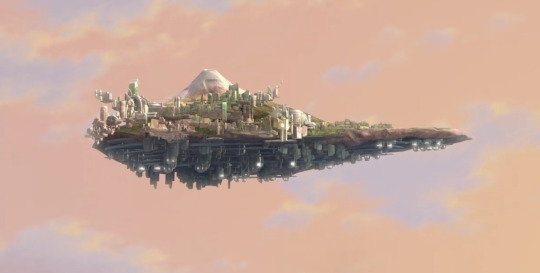
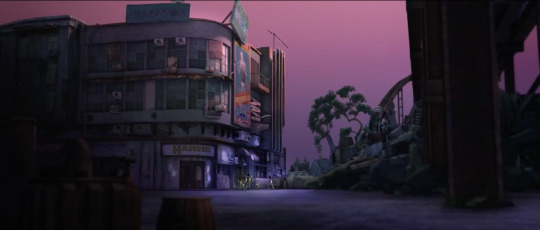
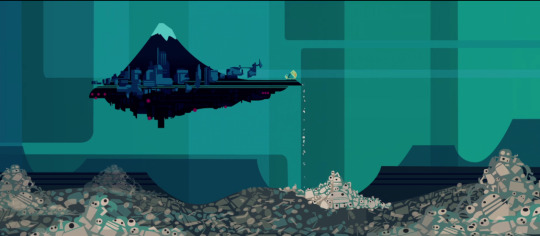
According to the opening of the film, Metro City was created when the people who would become the founders of the city noticed the world changing for the worse, and responded by taking part of the land and lifting it into the sky, creating a floating city - the opening voiceover refers to it as "an oasis, a floating paradise". Everybody else is left behind on what is referred to as the Surface, left to fend for themselves while the people of Metro City largely ignore their existence.
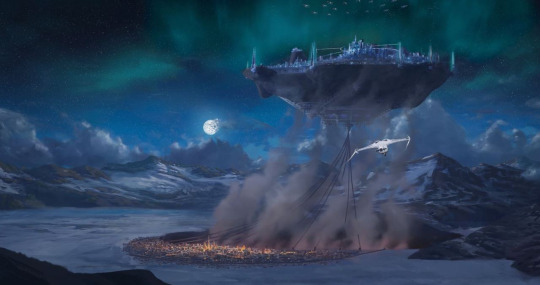
The parallels to Atlas and Mantle are crystal clear. Atlas and Metro City are both set up as a beautiful city above the clouds, meant to serve as an inspiration for the rest of the world. In reality, it's a place where the rich and privileged can live in comfort while shunning the poor. Meanwhile, down in Mantle/on the Surface, people are suffering and struggling to get by. Additionally, both 'surface' and 'mantle' are words that are associated with the ground.
The Blue Core (and the Red Core) - Penny's soul and Maiden powers.
Another concept that is (as far as my research shows at least) unique to the film is the Blue Core and the Red Core.

The Blue Core is a small sphere that is filled with pure positive energy, referred to as Blue Core Energy. It was created by Dr. Elefun, made from the fragments of a star that no longer exists - meaning that the Blue Core is all that's left, and cannot be recreated. This is reminiscent of how Pietro has no more aura left to spare, and thus is unable to give any more of his soul to Penny like he did the first time she died. In this allusion, the Blue Core is representative of Penny's soul and the power of the Winter Maiden.
When the Blue Core was created, there was also a byproduct - the Red Core. Essentially, it's the same thing as the Blue Core, but with negative energy instead of positive. If the Blue Core and the Red Core make contact, they both die - this is relevant later.
You could compare the Red Core to Watts’ virus, due to the way that it causes a robot to have red eyes and that it coming into contact with the Blue Core destroys them both.
Character Parallels
Before I get into this properly, I wanna give a quick side note. While Astro matches up to Penny perfectly, things get a little bit messier with the others in that we have a case of characters taking on multiple roles. However, this is far from unheard of in RWBY - let's not forget about how Blake represents both Belle and the Beast, Yang is sometimes the Beast to Blake's Belle, and Adam is an amalgamation of every antagonistic force in Beauty and the Beast. It's far from uncommon for a character to allude to multiple characters from the same allusion, or vice versa, which is what we see with some of the characters in this allusion as well.
Astro - Penny Polendina
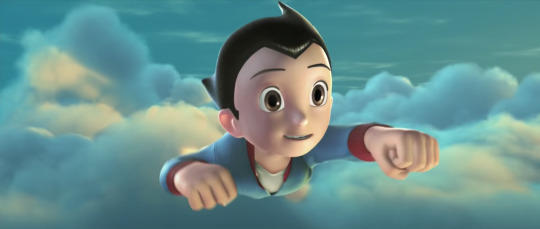

Unsurprisingly, Astro himself is our parallel to Penny.
After the death of his son Toby, Dr. Tenma rebuilds his son as a robot, using the Blue Core as his energy source. The Blue Core is stated to be unpredictable, and it's this that makes Astro who he is, what makes him unique from every other robot. As stated earlier, the Blue Core represents Penny's soul (and the Winter Maiden powers that are attached to it). When the Blue Core dies - and Astro dies with it - and Dr. Elefun is asked if he can be rebuilt, the answer is 'no' because the Core was unique and can't be remade - just like Penny's soul.
While Astro appears perfectly human on the surface, he's fitted with as much self-defence technology as Tenma could fit in him. The most iconic of these upgrades (and the only one that's consistent across every single version of Astro throughout the franchise) is the rocket boots. He even flies in a very similar way to Penny - pay attention to the posing, especially with the legs.
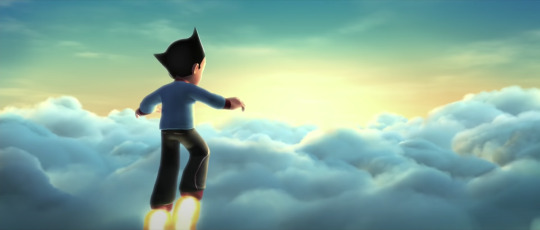

When Astro starts making friends with humans on the Surface, he conceals the fact that he's a robot, afraid of what they'll think of him when they learn he's not human. This matches up to Penny initially hiding the fact that she's not human, seeing herself as 'not a real girl'.
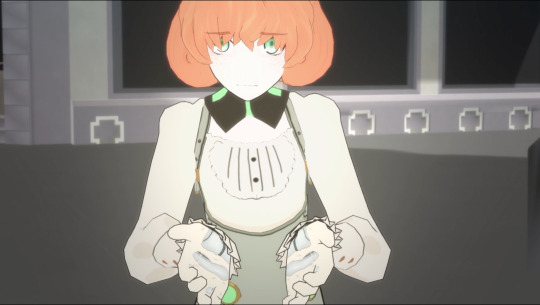
Astro has two father figures - Dr. Elefun and Dr. Tenma. Similarly, Penny has two father figures - Pietro and Ironwood.

During the climax of the film, Metro City starts to fall out of the sky and back down to the Surface. This is a parallel to two seperate moments in RWBY. The most obvious one is when Atlas is falling onto Mantle after the Staff of Creation is used. However, I think this scene more closely resembles the scene from Amity in which Amity Tower begins to fall.
When Astro sees that Metro City is falling, he immediately flies in to hold it up, despite the incredible strain it puts on him. This is a direct parallel to how Penny flew in to hold up Amity Tower.
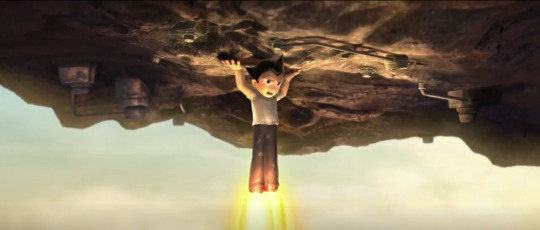
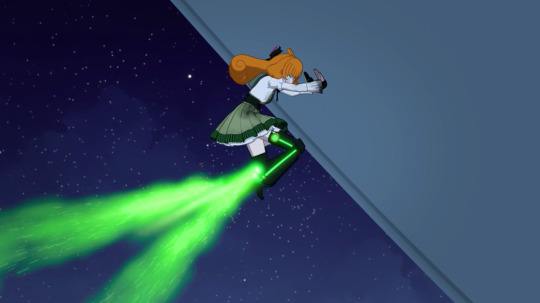
Astro pushes himself to the limit when he holds up Metro City, to the point where the flames from his boots burn so brightly that they turn blue - oh hey, doesn't that look familiar?

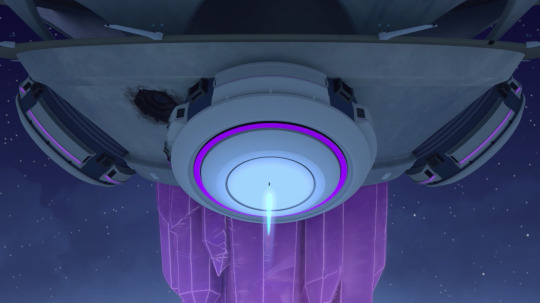
Astro also demonstrates self-sacrificial tendencies at a few points in the film. When he's captured in order to have his Blue Core taken out and placed into another robot, he simply accepts it, saying that "I think maybe this is what's supposed to happen...this is my destiny". This becomes a lot more interesting when you remember that the Blue Core is representative of Penny's soul and Maiden powers. Astro giving himself up to President Stone (the film's main antagonist who later ends up in a sort of 'fusion' with the Red Core) so that Stone can use the Blue Core could be a reference to the virus making Penny want to give herself up to Ironwood so that he can use her soul to open the vault - especially if we believe that the Red Core is connected to the virus in some way.
Near the end of the film, in the fight against the fusion of President Stone and a giant robot containing the Red Core (it's a long story, I'll get to it later in the post), Astro makes the decision to sacrifice his own life in order to destroy both the Red Core and the Blue Core, saying “this is what I was created for” and saving the lives of everybody else in the process. I doubt I need to explain how "choosing to die in order to protect other people" relates back to Penny in Volume 8.
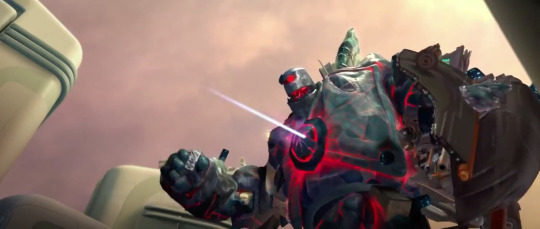
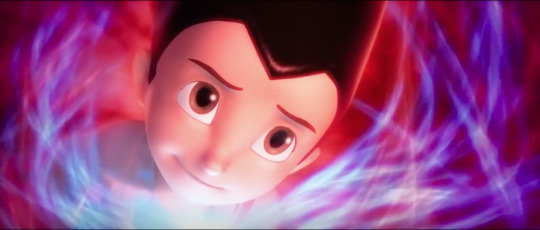
At the end of the film, and in the rest of the Astro Boy franchise as a whole, Astro takes it upon himself to be the protector of Metro City (and technically the Surface, but since Metro City has fallen, they're not exactly seperate locations anymore...). 'Robotic guardian of a city who's seen as a hero by the people' - you don't get much more obvious of a connection to the Protector of Mantle than that.
Additional details that may not be intentional but I still noticed anyway;
- Dr. Elefun describes as Astro by saying "That robot had more humanity than most of us". At this point, there's been many moments that affirm Penny's humanity - "You have an aura, Penny. A soul. That's who you are - our friend. Not a machine", "Her soul is who she is", the fact that she was able to receive the Maiden powers, all of these moments affirm that Penny has always been just as human as anybody else. This is also contrasted against Ironwood (and, for a while, Winter), who act more machine than human.
- Astro is actually rather heavily trans-coded. Penny is also trans-coded, but this is mostly likely a coincidence that happened as a result of the inherent transness of robots
- Elefun tells Astro that he's "not actually an entirely ordinary boy", which is reminiscent of Ruby describing Penny as "she's...not your typical girl."
- The shape of Penny's bow (the way that it sticks out more on one side while the other side is more vertical) looks similar to the shape of Astro's hair (this one was pointed out to me by @cosmokyrin when I mentioned this theory in the Frosen Steel server)
Dr. Elefun - Pietro Polendina
Dr. Elefun is one of Metro City's top scientists, and one of Astro's father figures. He is soft-spoken and gentle, a dreamer but a genius. In terms of personality alone, he's a pretty good match with Pietro. He's also the one who created the Blue Core, which draws a direct parallel to Pietro creating Penny's soul from part of his.
Dr. Elefun is the first person to truly see Astro as who he truly is. Dr. Tenma expects Astro to be a replacement for Toby, and is disappointed when he isn't. Similarly, everybody else sees Astro as a robot just like any other at first - an advanced robot, but nothing more than a robot. But Dr. Elefun gives him genuine praise, and encourages Astro to live his life and find his place in the world, just like how Pietro tells Penny that he wants to see her live her life.
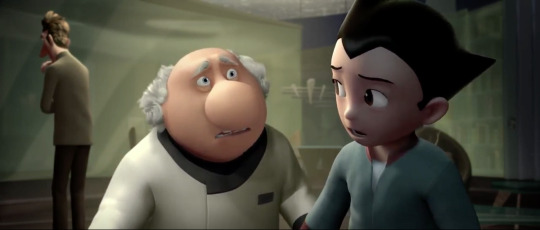

It's also worth noting that in most other versions of Astro Boy, Elefun takes the role of Astro's primary caregiver after Dr. Tenma no longer wants him.
President Stone - James Ironwood
President Stone is the current political leader of Metro City. For the entire film, his entire focus is on combat and military strength, and on multiple occasions he actively expresses his intention to start a war with the Surface. He believes that the best way to get re-elected is with a show of military force and violence.
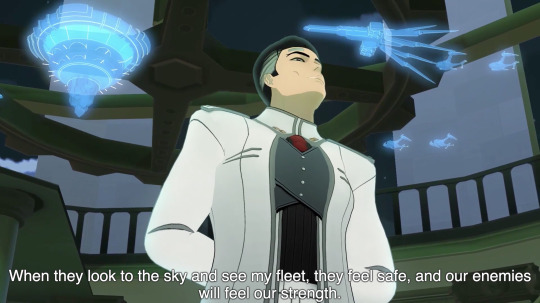
His primary goal throughout the film is to have Astro destroyed in order to retrieve the Blue Core and use it for his own gain. This is a direct parallel to Ironwood's goal in Volume 8 - to hunt down Penny and have her use her Maiden power to open the vault, and destroy herself.
Stone wants to use the Blue Core in order to power a specialised combat robot, ironically called the Peacekeeper. When Astro continues to escape his clutches, he decides to use the Red Core to power the Peacekeeper instead, but it doesn't completely go as planned. The Peacekeeper is equipped with what the film calls 'adaptive technology' - it's capable of absorbing anything it makes contact with into its own body.
And I do mean anything

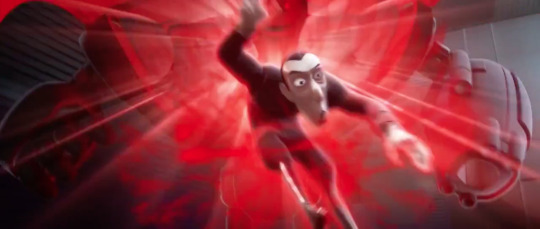
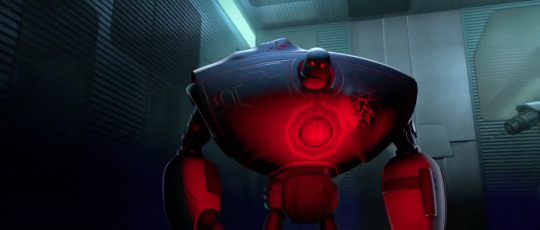
After Stone is absorbed by the Peacekeeper, he's in full control of it - essentially the Peacekeeper is nothing more than a metal outer shell. President Stone has become a fusion of man and machine.
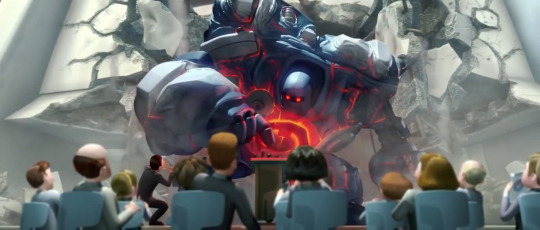

Dr. Tenma - both Pietro Polendina AND James Ironwood (a bit more Pietro than Ironwood but it's worth acknowledging both)
You might notice that while Elefun and Stone do have plenty of references to Pietro and Ironwood respectively, there are gaps where they don't cover every aspect of these characters and/or their dynamic with Penny. This is where Dr. Tenma comes in.
Dr. Tenma is Astro's dad, and the one who built him. He originally created Astro as a sort of 'replacement' for his biological son Toby after he died, giving Astro all of Toby's memories (more on this later). Naturally, this is a very clear connection to Pietro.
Additionally, Dr. Tenma uses the Blue Core - a completely unique, one-of-a-kind technological marvel - in order to power a single small robot that's intended to be nothing more than a replacement for his son, saying "I can't lose him again!". In this moment, Dr. Tenma is so focused on not losing his child that he doesn't acknowledge the big picture.
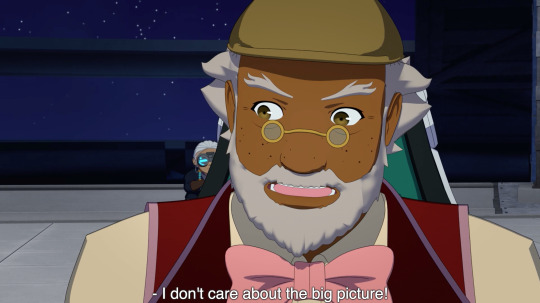
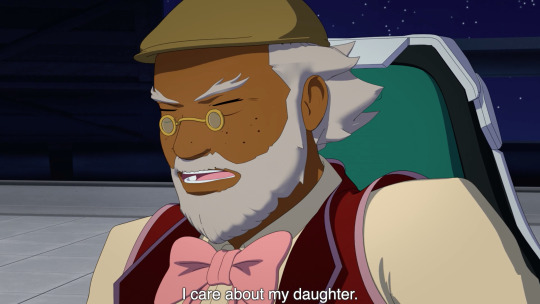
However, once Dr. Tenma realises that Astro isn't a perfect replica of Toby, but rather his own person, Tenma discards him, not caring if Astro gets destroyed or not. Similarly, when Penny stopped doing what Ironwood wanted her to do, Ironwood stopped caring about her as anything more than a container for the Maiden powers and is perfectly willing to let her die once the vault is opened.
Luckily, Dr. Tenma does have a change of heart, deciding that while Astro isn't Toby, he's still his son. Near the end of the film, Astro is very injured, and Dr. Tenma encourages him to get far away from the danger. However, Astro refuses to back down, instead choosing to sacrifice his life in order to stop President Stone, despite Dr. Tenma begging him not to go. Here, we have yet another parallel to this moment in Amity.
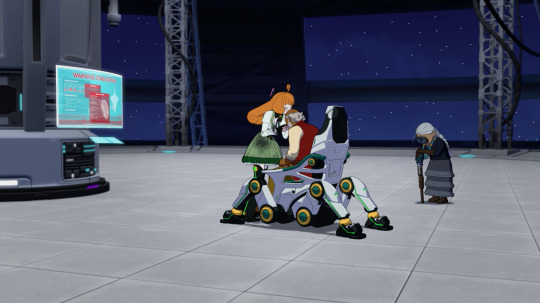
Bonus (aka characters that aren't perfect allusions, but connections do exist)
When Astro ends up on the Surface, he's taken in by a man who calls himself Hamegg. Hamegg ends up being a jerk, and while his personality and actions in the film don't particularly match up with any characters in RWBY, his backstory is a perfect match to Watts - a head scientist in Metro City who was shunned and fired for reasons unknown (Hamegg claims that they were 'intimated by his ideas and talent', but this was when he was trying to impress Astro and he lies a lot anyway, so this could be a complete lie).
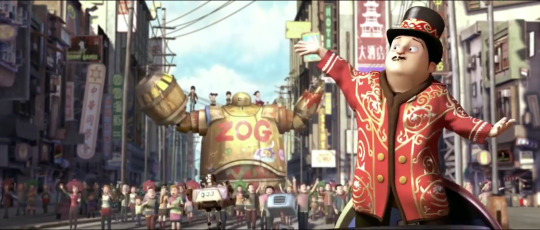
On the Surface, Astro befriends four human kids (Cora, Zane, Sludge and Widget) and their robotic dog, Trashcan. While the personalities don't really match up (though Cora, Astro's closest friend, does bear a visual resemblance to Ruby), the idea of a 4-person group + a dog could be a parallel to Team RWBY and Zwei.
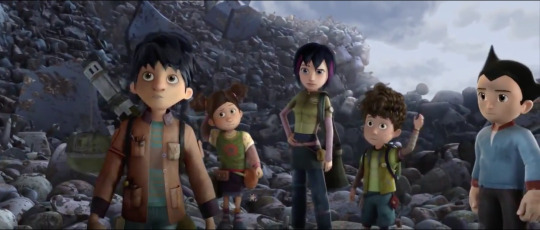
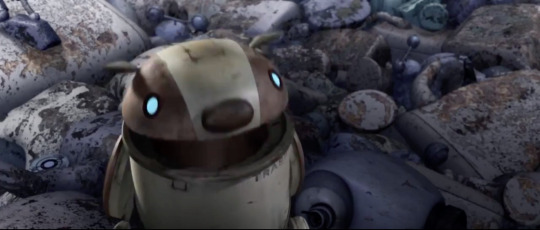

Zog is a very old, very large robot that had been 'dead' for several years until Astro found him and revived him by giving him some of his Blue Core Energy. Zog is our allusion to Winter - Astro giving Zog some of his Blue Core energy is a parallel to Penny giving Winter the Maiden powers. Additionally, in The Final Word, Winter explicitly calls herself a machine. While this does have significance on it's own, it could also be a nod to this allusion. That being said, the main connection between Winter and Zog (and possibly the most important part of this post) is based on events that have yet to happen in RWBY canon, and so I'm saving that part for the end of the post.
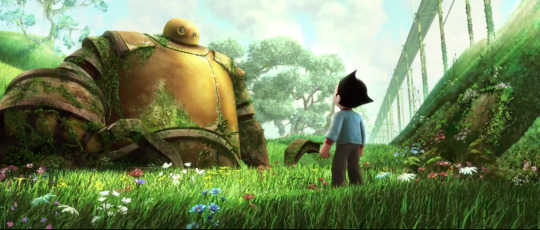
Story Parallels
Toby's Death
Toby Tenma, Dr. Tenma's biological son, was very similar to Astro in terms of personality (with some key differences), as well as having a strong physical resemblance.
When the Blue Core and the Red Core were first being shown off to President Stone, Toby was accidentally locked behind a sealed off barrier, trapped with the Peacekeeper containing the Red Core. Toby was killed in a blast that completely disintegrated him, leaving nothing but a hat containing a single strand of hair.
This hair is important, because Dr. Tenma used this hair in order to extract Toby's DNA and memories, which he was then able to implant into Astro in order to make him resemble Toby.
This scene is most likely a parallel to Penny's first death in the Vytal Festival. In her first death, Penny's body was destroyed, but her core remained intact. Her core, which contained all of her memories, was the key piece in properly putting her back together without erasing who she used to be. The strand of hair containing Toby's DNA is representative of Penny's core containing her memories.
Additionally, there's the fact that when Toby was rebuilt as Astro, he was given various upgrades to allow him to better hold his own in a fight, with the most obvious behind the ability to fly via rocket boots. Penny received similar upgrades when she was rebuilt as well.
It's worth acknowledging that Toby's death could potentially parallel the moment that Ambrosius separated Penny from her robotic body, with the strand of hair instead being her soul, separated from her dying body and then disintegrating. However, due to the timeline and order of events, I think that Toby's death is more likely to be a parallel to Penny's first death, and her separation from her robot body is instead a parallel to the next scene I'm about to mention.
Momentary Death
When Astro is captured by President Stone and taken back to Metro City, Dr. Tenma actually does remove the Blue Core from his body, which does cause Astro to temporarily die.

Luckily, it only takes a few moments for Dr. Tenma to change his mind and return the Blue Core to Astro, reviving him.
Astro's 'soul' was removed from his body, causing that robotic body to die, even though in the end Astro does survive it. This is reminiscent of Ambrosius removing Penny's soul from her robotic body, letting that body die, while Penny survives.
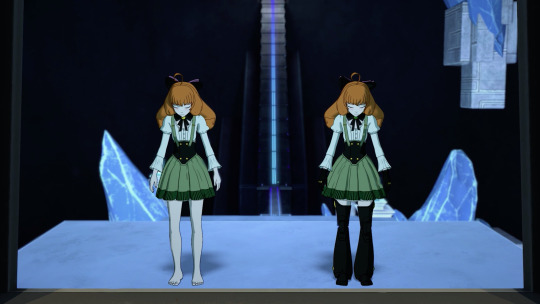
Zog
I briefly went over Zog earlier, but I wanna go into more in-depth about him, because the parallels between Winter and Zog and the implications of said parallels are the main reason I ultimately decided to make this post.
As I said earlier, Zog is a very old, broken down robot that nobody has been able to revive in years. When Astro finds him, he brings him back to life by giving him some of his Blue Core Energy. Astro essentially gives Zog some of his lifeforce, a part of his soul.

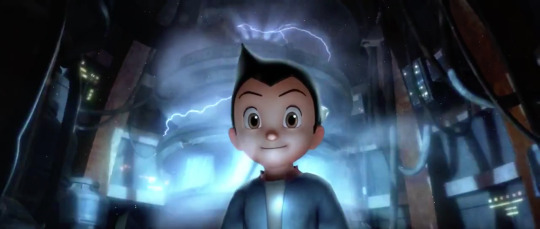
Winter was on the verge of death at Ironwood's hands, but Penny was able to save her by giving her the Maiden powers, and her soul with them.
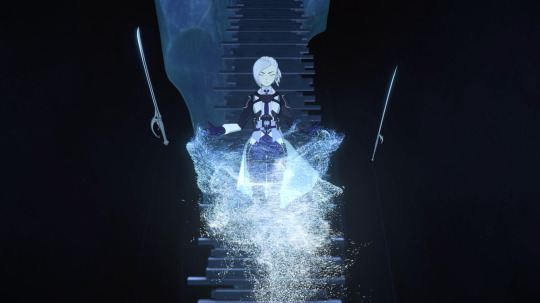
However, Zog doesn't keep all of the Blue Core Energy Astro gave him all to himself...
Resurrection
As I've mentioned a few times in this post, Astro does die - and I mean properly die, not a death that lasted 2 minutes at the most and had no consequences. Astro sacrifices himself and his Blue Core dies, all in attempts to protect the people of Metro City/the Surface and his friends. Dr. Elefun says that he can't be rebuilt because his Blue Core, his soul, was unique.

But then, Zog comes around. Zog, who is holding onto what is a part of Astro's soul - the only surviving part of Astro's soul. Zog returns some of the Blue Core Energy to Astro, which brings Astro back to life.

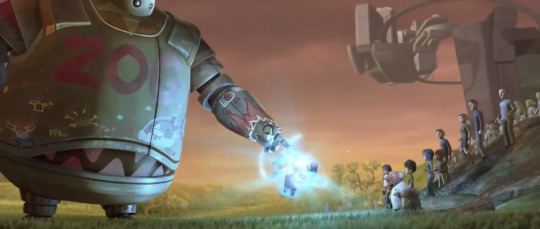
So, to recap: Astro gives a part of his lifeforce, part of his soul, to Zog. When Astro dies, Zog gives some of that soul back to Astro in order to revive him.
If you've been looking at the theories regarding Penny and Winter recently, this will sound VERY familiar. While the specifics vary, the essentials of the most popular theory is that Penny transferred her soul to Winter to hold on to along with the Maiden powers, and that somehow, Winter will return that soul to Penny in one way or another (either by putting her into another robotic body, or just somehow extracting her soul and letting it form it's own body again). The fact that this movie has these exact events occurring makes this seem more and more like the most likely route.
If Penny really is an intentional allusion to Astro Boy - which, based on the sheer length of this post, seems pretty damn likely - then the film practically spells it out for us. Winter will give part of her aura, the part that Penny gave her, in order to bring Penny back to life.
thank you for coming to my ted talk
#rwby#penny polendina#rwby v8#rwby theory#rwby volume 8#I've spent the past 2 days working on this#but the amount of parallels is insane#there's lots of bits and pieces I left out too#combine this with Pinocchio's three resurrections and the Narnia/Aslan theory and that's three allusions that foreshadow Penny's return#honestly I was just kinda chilling in my room yesterday when suddenly the scene with Zog came to me and I yelled HOLY SHIT out loud-#-because I realised it was the exact same scenario#there's probably some typos here and i could've included more pictures but like...it's 4am#and this thing is like 4000 words
480 notes
·
View notes
Text
Sonification of Electricity usage
I have a smart meter with a display in the hall. Trouble is, I hardly ever look at it and the data shows cumulative values rather than the energy being used right now. I had the idea of sonifying the data being recorded by my ESP8826-based electricity monitor. Currently it reports every minute to my sensor dashboard.
I initially thought of running this on an ESP32 or Pi Pico W since both have onboard Wifi which could be used to retrieve the current data from the dashboard. I looked at a few ways to do this, such as using Midi and even ordered a sound module.
However it occured to me that rather than build a device to play the sounds, it could be done as a web page using JavaScript to play the files. At the very least, this would be very useful for testing sonification schemes .
The key HTML feature is the <audio> tag to define the audio resources and the Javascript API to play the audio track. Playing around with this feature, I realised that audio tracks can be looped and can run in parallel and the volume of each track can be changed as the tracks are played.
An update rate of once a minute is too slow to show devices being turned on and off so the ESP8266 monitor was changed to report to another channel every 6 seconds to the dashboard. Only the latest record is recorded on this channel since a full history would be too large. This reading is fetched from the dashboard at the same rate. I'm exploring the idea of multiple sound tracks whose volume is adjusted in response to the level of usage. Currently I'm using six bird songs. Tracks are allocated to bands and as the level of energy usage, measured in watts, increases, tracks are brought into the soundscape with increasing volume.
This approach looks promising because it can be run on a phone and carried around the house, and can be listened to when away from the house. This is the current version. Data fetching and sounds can be turned on and off and the thresholds changed.
The problem now is to design the soundscape and thresholds to best represent the changing energy level.
Other sonification ideas
I'd like to look at getting the national Grid data - obtainable via an API described in https://bscdocs.elexon.co.uk/guidance-notes/bmrs-api-and-data-push-user-guide
This and data from the tree moisture sensor are multi-channel and will need a different approach to generating the soundscape
Extras
Grid in January 2013
Bought this CJMCU-1334 breakout board for playing MP3 files £9
Tutorial
alternatively ESP32 supports BLE which could be used to send MIDI derived sounds to a phone
Free sounds https://freesound.org/
2 notes
·
View notes
Text
Ewan McGregor: My Serotonin Booster
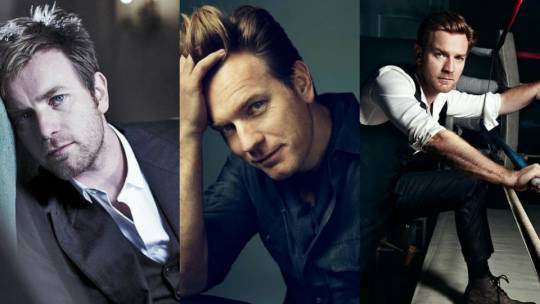
[P.S: Upon the time of writing, I have yet to watch most of his films including The Island, Beginners, Salmon Fishing in the Yemen, Trainspotting along with some of his series/documentaries including Fargo, Long Way Round and Long Way Up]
I have known many celebrities who has given me happiness these past few years, but it was during quarantine when I needed someone the most. Don’t get me wrong though, many of the people whom I discovered during the start of quarantine still provides me happiness until now, the only difference being that there is a specific someone who really provides me the dose of serotonin that I really hunt and yearn for, that specific someone being Scottish actor Ewan McGregor.
Before I get to the cheesy part (I guess), let me narrate the timeline on how I found my happiness in him.
I first saw him as the debonair bronze candelabra Lumiere who sang the iconic song “Be Our Guest” in 2017’s live-action Beauty and the Beast. I instantly found Lumiere charming and cute in that film and him being head over heels in love for Plumette (played by the gorgeous Gugu Mbatha-Raw) is so cute and adorable, not gonna lie. Also, a moving candelabra singing and dancing in the middle of your dinner table is such a cute visualization, don’t you think?
A year later, Ewan then brought me back to childhood nostalgia through the lens of Christopher Robin, where he played the titular character. Seeing that film for the first time and watching him interact with Pooh, Piglet, Tigger and the other characters in the Hundred-Acre Wood has awakened the child in me. I honestly melt everytime I hear Pooh’s voice (voiced by Jim Cummings) since that voice was what made Pooh one of the cutest bears in the world of cartoons. Also if you observe in the film, there was a scene where he (Christopher) twirled his umbrella like a lightsaber when trying to "kill" a “Heffalump”. That scene kinda made me giggle and also made me think if it was just Ewan’s muscle memory or not.
Fast forward 3 years later to the current year of 2021, I have made a galactic discovery through Star Wars (yes, I know, I’m so late to the rave but hey, better late than never, right?) and through this galactic discovery, I met the sassiest, kindest, strongest and iconic Jedi warrior Obi-Wan Kenobi. I honestly applaud both Ewan and Sir Alec Guinness for their portrayals of the live-action versions of Obi-Wan as well as James Arnold Taylor and Stephen Stanton who voiced Obi-Wan in the animated series The Clone Wars and Rebels.
Now, believe me when I say that I fell in love with the animated Obi-Wan first because of The Clone Wars. Falling in love with the animated version then made me fall for the live-action version which Ewan portrayed flawlessly. It was really obvious in Ewan’s performance as Obi-Wan how much he paid homage to the Obi-Wan of Sir Alec Guinness and I really admired that. Plus, the iconic (and meme-worthy) lines are utterly unforgettable and it made me so happy to hear that he’s coming back as Obi-Wan in his own series on 2022. It was honestly through the character of Obi-Wan where I really started to love Ewan and because of this, I started to dig and binge some of his past and recent work.
Now armed with the yearning to look for and watch more of his movies, I scoured the internet and I found Birds of Prey among the list of his movies. First of all, I was utterly surprised when I found out he was involved in an all-female movie, but I was even more surprised when I found out that he was playing Roman Sionis, a.k.a Black Mask, who is the main villain in the movie. Truth be told, I have a history of loving villainous characters and he was no different. I honestly found him convincing as a villain, egotistical at best and was kind of saddened when he *spoiler alert* died at the end. I was hoping he would come back in a somewhat miraculous way, but I could accept if that’s how his story ends.
After watching Birds of Prey and witnessing him play a villain, I delved into the world of fashion design through the lens of Halston which is a Netflix series about Roy Halston, a famous fashion designer back in the 70s. Ewan played Halston flawlessly, and while some scenes made me cover my eyes because of explicit content, I still enjoyed the show overall not only because of Ewan but because I got to understand what Halston was really like behind the curtain, if you’d like.
Now, I am not the biggest horror movie fan but I faced my fear when I met Doctor Sleep himself, Danny Torrance. Considering that this is the sequel to “The Shining” which is deemed the scariest horror film ever made, I braced myself for it to be horrifying and I would be jumping out of my skin while watching it, and I did in several scenes. I applaud Ewan for playing the grown-up version of Danny and making me understand his story through this film.
After that horror experience, I decided to watch something that speaks to my heart and that is a movie with music, and Moulin Rouge was the perfect one. Now, this movie is highly recommended for every Ewan McGregor fan, because he showcases both his acting chops and his powerful vocals in this movie. I instantly fell in love with the penniless writer Christian, his sweet smile, kind spirit and utter obsession with the idea of love. Also, those songs he sang with Satine (played by the angelic soul that is Nicole Kidman) are automatic auditions to my playlist. Also, that drama at the end when Satine died and Christian was grieving, it made me tear up indeed.
After drama comes more drama, I went into a real-life story and that is The Impossible where he played Henry who is the husband to Maria (played by Naomi Watts) and father to 3 kids, one of them being my favorite Spiderman Tom Holland. Believe me when I say that the movie pulled at my heartstrings, especially after the tsunami hit and the family got separated as well as the scene where Henry (Ewan) was at this one camp and he was speaking on the phone while crying. I really felt the “dad” emotions there, knowing that he is a dad in real-life. This movie, even though you are a fan of Ewan and Tom, is not for the faint of heart.
The latest addition to my list is the knight-in-shining armor that is Elmont from Jack the Giant Slayer. He is a feisty one, let me tell you that. He does not give up easily and boy, does he look hot with that crossbow. Anyways, him as Elmont was a fantastic casting, showcasing the selfless persona of a knight who was willing to protect his kingdom above all else. The mini swordfights in between serve as bonuses.
Please do know that I will be watching more of his work as the days progress, but while writing this, this is all that I have seen.
Finally, I’m done with that lengthy timeline narration and now, onto the chessy-ish part, because it depends on perception if you are willing to think of my love for him as obsession or just dedication.
For the most part, I can’t really describe how happy he makes me. It’s as simple as me hearing him talk in interviews with that lovely Scottish accent of his, hearing him sing covers of songs and seeing his pictures on Pinterest (I have about a hundred of him on a board on the app, along with a few Star Wars characters) and the internet in general or it’s as bizarre as me smiling when I see a photo of him with a silver hoop piercing on his left ear or as scenic (I don’t even know if that’s the right word) as when I see a clip/GIF of him running his hand through his hair. I don’t really know and therefore can’t describe what is this feeling I feel when I see him.
Recently, I’ve been binge-watching his interviews on Graham Norton, Jimmy Fallon, Jimmy Kimmel and other outlets and I can’t help but smile amidst him repeating stories and saying the same spiels and all, there’s just something about his presence that makes me feel happy. I’ve also been listening to his covers of songs and him playing the guitar and I melt. I mean, even with his mundane fashion sense, his charisma just stands out for me. Also, his point of views on career and why he chooses the projects that he does is inspirational. I just love, adore and admire him, amidst all the controversy (which I’m not gonna go deep into because that’s all in the past) that happened.
At the end of the day, all I can takeaway from all of these, is that Ewan really makes me happy. With his expressive blue eyes, charming smile, melodic voice, and sweet personality, he can easily lift up my spirits as high as the galaxies can reach. If only I could tell him all of these, but I would just faint and stutter if I were to see him face-to-face. But seriously, given the chance to speak with him, I would tell him how much he means to me and how much brighter the world is because of him.
I’ll just end this lengthy narration with a line from “Your Song”, which is originally sang by Elton John and Ewan sang it beautifully in Moulin Rouge and is now one of my favorite songs.
“How wonderful life is, now you’re in the world”
24 notes
·
View notes
Note
Hi there :) I am hoping you have a bit more knowledge here but Ian very confused about the “queer baiting” and the apparent gay relationships for chakos? Are they actually portraying that because I saw a little thing that described zeha having a crush on a man and then saying no I don’t like men? Is this watt pad version different to the webtoon?
Hi anon:) I actually stayed up last night and read the Wattpad episodes in order to respond to your question. This is what I do for blogging, lol.
Let's just take for now what you mentioned in your ask, without taking into consideration the full story that is out until now and no other context. If a character in story, here Zeha, has an internal monologue in which he describes what he feels when he meets another man for the first time, but then in the actual dialogue exchange he says he doesn't like men, then we have a form of internal conflict. The story is ongoing, we don't know where it would lead, so there is no way in which this is a situation that can be labeled as a form of queerbaiting. And that's not what queerbaiting is anyway. We also need to know how to differentiate between subtext, queer coding, and queerbaiting. I actually recommend a book called Queerbaiting and Fandom, written by Joseph Brennan. In the introduction he provides context and definition to certain terms that we should apply when it's appropriate.
As to Chakho and how the relationship between the 7 characters is portrayed, until now (10 episodes) only 4 of them have made an appearance. Zeha, Haru, Do-Geon and Hwan. Zeha and Haru have teamed up from the beginning, only for Do-Geon to show up later, while Hwan was merely just introduced. The little thing you mentioned was about the meeting between Zeha and Do-Geon. Yes, both of them say that they felt as if they fell in love the moment they met and that is because it was the only way in which they both could describe the intense feeling that they had. But in later episodes there is also a situation in which Zeha (I think) thinks of Do-Geon as maybe a brother he never had. In my opinion, I don't see any apparent gay relationships in Chakho, given the story that was provided until now. This webtoon was promoted as 7 people who are connected by fate and they deal with hardships together while they mature in the process. If in the future episodes, there is (sub)text that there is a relationships between two men, that is left to see. I don't think it's possible to reach such a conclusion as of yet.
Chakho is a work of fiction that is said to have characters which have some personality traits inspired by the BTS members. The characters are not the BTS members. I know we all know this, but I just wanted to remind that, because as obvious as it is, from what I can see online, there's already a mix between reality and fiction and that can be dangerous (I said this would happen, so no surprise here). But, that doesn't mean some parts of the BTS lore have not been used as a sort of inspiration for the relationship between the fictional characters. And no, this is not material made in order to promote ships (at least nothing that could lead to that conclusion up until now). When I say BTS lore, I mean certain stories that are usually told by the members themselves that have become part of the BTS story. One of it is the meeting between Jungkook and RM pre debut. We hear Jungkook talking about a sort of crush (in Winter Package 2021). That is a story told numerous times during interviews and other types of BTS content (repeated ad nauseam if I dare say so). It's one part of the BTS genesis. Now, we can look at this situation and see something similar in the first meeting between Zeha and Do-Geon, but it stands more as a metaphor for encountering people that could have an impact in someone's life and the importance of it. Do I feel it's ok to use real life situations, especially in this context, and integrate them in a work of fiction on webtoon and wattpad? No. Because I see it as just another way in which the company milks the members and their personal relationships. Leave that to the fandom, to write fanfiction on Ao3 (they do a better job in terms of storytelling, but that's just a personal opinion).
10 notes
·
View notes
Text
So, let’s talk about James’s semblance, Mettle.
Ironwood's Semblance, Mettle, strengthens his resolve which allows him to carry through with his decisions, helping him hyper-focus (RWBY wiki)
Actual quotes on Ironwood’s semblance from the RTX RWBY Panel.
“So Ironwood does have a semblance. We - it’s in the show, it’s in like little bits, you can kind of see it. It’s more like a passive semblance that runs in the background.” Eddy Rivas
“The whole thing is just this kind of like, iron resolve-slash-will that like kind of powers him to - almost like a very stubbornly, narrow-set focus like mind set on things, to kind of like push himself to do what he’s decided he’s gonna do-” Eddy Rivas
“It kind of helps him like, hyper focus,” Kerry Shawcross
“Or like, pushing through something like searing the flesh off your arm. If like, this is the goal he needs to accomplish, everything else just goes by the wayside.” Miles Luna
“So that’s kind of running in the background of seven and eight a little bit.” Eddy Rivas
“So it felt a little weird and we just never put it on the page, but you can actually see it happening.” Eddy Rivas
“We could possibly get it out later, but we thought it’d be more fun for you to be able to watch volume eight, and go back and watch volume 7 knowing that.” Kerry Shawcross
So I’m going to be talking about some of the problems I think there are with Ironwood’s semblance and it not being included in the show. I’m going to be very critical of and bashing RWBY, and there’s probably going to be CRWBY bashing too. If you don’t want to see any of that or if you’re against any sort of pro Ironwood content, don’t read this post or interact.
So let’s try to piece together from these statements what Ironwood’s semblance is.
It’s a passive semblance. As far as I know, the only other passive semblance we have to judge how those work is Qrow. Unlike active semblances, Qrow’s passive semblance can’t be controlled, and can only be increased at will, but always runs at frequencies severe enough that Qrow thinks of it as controlling his life and preventing him from being able to be close to his family. From the way Qrow’s semblance behaves, we can extrapolate that James’s semblance likely works in the same way, and in the panel, it’s described as ‘running in the background.’ I.E. He can’t turn it off, it runs through his entire life, he can only increase it in certain times.
It’s described as hyper-focusing, stubbornness, narrow-set focus, being unable to concentrate or care about things outside of his set goal, and pushing himself in doing what he’s decided he has to do.
There are several reasons I want to talk about this semblance.
1. This semblance might’ve been newly invented for season 7 and 8. Why do I think this? Eddy Rivas says ‘I believe we called it Mettle’ in the panel (emphasis is mine,) and is talking like he was included in inventing it, even though he became a co-writer for volume 7. Also they don’t mention if it affected Ironwood pre-volume 7, they only mention it being seen or considering including it in volume 7 and 8. Also, the voice actor of James Ironwood didn’t know about this semblance until a fan told him. It’s possible that this semblance was written earlier, but I doubt it and I think that this semblance was invented in the conception of volumes 7 and 8 with Eddy Rivas being involved. As such, I’m going to view everything pre-volume 7 as actions we were intended to consider James’s actual character, and everything post-volume 6 as actions influenced by his semblance.
2. The fact that it’s not included is lazy. This is a character defining semblance. This colors literally everything that Ironwood does in seasons seven and eight, this is a major game changer, this changes any understanding of the character. I’ve said this before, but fans shouldn’t have to do homework to understand the story. Many fans don’t want to go searching through panels, wikis, books, and zoom meetings to try and piece together why a character might be the way they are or how the magic systems work. The fact that the semblance isn’t included has led to confusion about how the semblance works. Some RWBY fans will present the way they decided the semblance works and get actively angry at fans who headcanon that it works differently or are upset with the way the creators themselves described the semblance. Other fans act like RWBY critics who think Ironwood’s fall to villainy is hard to track are stupid for not knowing this completely unincluded detail, and other fans villainize the semblance and use it as a reason why Ironwood is an inherently bad person. On the flip side, James Ironwood fans are rightly confused at this semblance that seems like it could be an explanation for the sudden shifts in his character. Some of them don’t understand why this semblance isn’t explained and at least treated as a part of his fall and treated more sympathetically. The fact that it wasn’t explained in the show leads to fans coming up with their own conclusions, and then arguing over what version is viable or what the collective fandom should accept.
3. The semblance itself is a lazy explanation for his villainy. The creators didn’t write a convincing hero-to-villain story. Ironwood’s leaps in morality are made with very little groundwork or explanation, he goes from ‘doing what he feels needs to be done’ to threatening to bomb the remaining citizens of Mantle in a completely irrational time with laughter and smiles over the course of a season that didn’t really put the focus on that progression. The semblance wasn’t explained or even mentioned and Ironwood wasn’t treated with sympathy or understanding, because we were meant to hate him and see him as the enemy to the protagonists, who we were meant to see as completely right. But the semblance is then an easy explanation that ‘fills out the plot holes’ if CRWBY is asked, that they can use to justify the fall to villainy - or use to suddenly redeem James if they decide they want to. And as I said before, this semblance is already being used by the mega-fans to explain the fall to villainy and throw it in the faces of any critics. Once again, it feels like the writers are just coming up with whatever they can to make up for their shitty writing, while they also rely on their fans to fill in the gaps and ‘explain’ to critics exactly how they think the semblance works and act like the critics or bashers should’ve just come to the same conclusion they did.
4. The semblance is problematic because of how villainized James is specifically for things like his semblance. The semblance is literally the best possible explanation for Ironwood’s fall and the only one I’ve heard that makes any sense. But his semblance is literally described by the creators as ‘hyper-focusing.’ The fact that his semblance is treated as something that makes him more of a villain and something that aids in his destructive behavior that isn’t ever treated with an ounce of sympathy or understanding, is a really bad look. There are real-life people who hyper-fixate on things and can’t help it, and while James’s semblance might not be hyper-fixating exactly, CRWBY still hurt people with the way they talked about this semblance and how they included it in Ironwood’s fall. I’m not diagnosed and I’m therefore never sure of this, but I think I’m ADHD and hyper-fixate on things (like RWBY, lol.) I’ve never been sure exactly how I view Ironwood’s semblance, but hearing the way that the CRWBY head writers talk about it made me feel like I should keep that side of me from people who don’t know me well like my co-workers. Whether or not it was intended, that’s what CRWBY did, and there are many more people than just me who were hurt or bothered by this personally.
5. Since I’m assuming this semblance was a new addition to James in season 7 and 8, it really honestly feels disconnected. It’s a passive semblance, it’s meant to affect James during the course of his whole life because he can’t turn it off. But in volumes 2 and 3, he seems honestly receptive to Oz, listens to him, never goes too far, never seems too stubborn, never seems to ignore other problems to focus on one thing more than what’s perfectly normal for regular people. Before literally near the tail end of volume 7, Ironwood acted like a regular person unaffected by a semblance at all, who just happens to be a determined person facing hard situations. It really feels like the semblance was invented to explain the jump to villainy, and then used to explain how he did things like sear the flesh off of his arm in the Watts fight to be like ‘look, this didn’t come out of nowhere! There it is in this scene!’ which is really lazy. And the disjointed feeling between Ironwood from his first appearance and Ironwood post-shooting Oscar still takes you out of the story and makes you go ‘wait, what’s going on here?’ You shouldn’t be able to see the hand of the author, but it was very clear to me that the writers just wanted villain!Ironwood and just did whatever the hell they wanted to get there whether or not it made sense or what they had to force or forget to do it.
6. This semblance... Really makes Qrow look like a jerk. It makes everyone look like a jerk, but it especially makes Qrow look like a jerk. There’s a very, very strong probability that Qrow never had any idea about this semblance that Ironwood couldn’t control. But after spending volumes sympathizing with Qrow and feeling bad for him and understanding that a lot of his problems stemmed from his horrible lot in life that he wrongly blamed himself for, to see him ready to kill a former friend who is even more affected by and ruled by a semblance than Qrow ever was made me seriously annoyed with the writing. In my opinion, they should’ve had Qrow know about his semblance, know that it was affecting his every choice, be deeply sympathetic and bothered by the situation, and be trying to get out of jail so he could break Ironwood’s aura and jolt him out of his affected state. It would’ve been much, much better in my opinion, for Ironwood’s character, Qrow’s character, and the story as a general whole. The way that villain Ironwood was done just is not interesting to me in any way. Not only did CRWBY miss any opportunity to present a compelling hero-turned-villain story, but they also invented a reason for Ironwood to be deeply sympathetic and easily redeemed and then made no one understand that this was a problem and seem to be going out of their way to act like it’s not there at all to make Ironwood a full villain! Why give him the semblance at all if they were going to not use it and expect everyone to want him to be a full, incredibly hard to redeem, EVIL VILLAIN?
I seriously can’t understand CRWBY’s choices. In my opinion, they should’ve either made Ironwood a sympathetic hero forced into doing villainous actions by this semblance that they should’ve rephrased in terms of how it works, or they should’ve just left him with no explained semblance.
Also, I think Mettle is a stupid name.
#rwde#rwby criticism#anti rwby#anti-rwby#anti crwby#rwby hate#pro ironwood#ironwood defense#pro-ironwood#rwby bashing#this post contains rwby hate
70 notes
·
View notes
Link
Simon Gilbert
Simon Says
We interviewed Simon Gilbert, Suede’s drummer, whose book So Young: Suede 1991-1993 is a journal and photographic document of the band’s early years that will be published October 8th. So Young has foreword by journalist Stuart Maconie and a vibrant, lively text by Simon himself, documenting his move from Stratford-on-Avon, his hometown, to London, the audition with Suede, life in the van, the early success years and the many amusing things that come with it. It is one of those rare books that make an outsider feel like they were there, in the van. Or in absurd mansions in L.A. belonging to industry types. Or was it record producer(s)?…
The conversation extended to Coming Up, Suede’s third album that turned 25 this year and drumming. Simon’s witty, often, one-liners contrast with my more elaborate questions, proving an interesting insight into our way of writing/replying.
by Raquel Pinheiro
So Young: Suede 1991-1993
What made you want to realease So Young?
I was searching through my archives when researching for the insatiable ones movies and found lots of old negatives and my diaries. They had to be seen.
When and why did you start your Suede archives?
As you can see from the book, it stared from the very first audition day.
From the concept idea to publishing how long did it took you to put So Young together?
30 years … I’ve always wanted to make a book since I was first in a band.
What was your selection process for which items – diary entries, photos, etc.- would be part of the book?
I wanted to form a story visually with a few bits of info thrown in here and there, also most of the photos tie in with pages from the diaries.
Which methods, storage, preservation, maintenance, if at all, do you employ to keep the various materials in your archives in good shape?
Boxes in an attic … one thing about getting the book out is that I don’t have to worry about the photos getting lost forever. It’s out there in a book!
Other than medium what differences existed between selecting material for The Insatiable Ones documentary and for So Young?
Video and photos … photos don’t translate well on a TV screen.
Do you prefer still or motion pictures and why?
I prefer photos … they capture a particular moment in time … as video does, but there’s a unique atmosphere with a photo.
So Young’s cover photo has a very Caravaggio and ballet feeling to it. Its chiaroscuro also contrasts with the images inside. Why did you choose it for the cover?
It was a striking shot and I wanted the book to be black and dark …it fitted perfectly.
How many of the photos on So Young were taken by you?
Probably about 3/4 my 3 school friends who were there with me at the beginning Iain, Kathy and Phillip took a load of us onstage, backstage, after the gig, etc., photos I couldn’t take myself.
So Young can be placed alongside books like Henry Rollins’ Get in The Van and Michael Azerrad’s Our Band Could Be Your Life, that not only chronicle and show the less glamorous, more mundane side of being in a band, but also totally immerse the reader so deep in it that we are there, feeling and going through the same things. Was your selection of materials meant to convey that “band being your(our) life” sensation?
Yes, exactly that. I was fascinated by photos of bands, not on the front cover of a magazine or on TV. The other bits of being in a band are far more interesting.
In the foreword, Stuart Maconie mentions the brevity of your diary entries which, as someone who keeps diaries, I immediately noticed. Do you prefer to tell and record a story and events with images?
I haven’t kept a diary since the end of 1993 … looking back on them they can be a bit cringeful … So, yes, I prefer images.
Contrasting with the diary entries brevity your text that accompanies So Young is lively, witty, detailed and a good description of the struggles of a coming of age, heading towards success, band. Do you think the text and images reveal too much into what it really is like being in a band, destroying the myth a bit?
I think the myth of being in a band is long gone … Reality is the new myth…
In So Young you write that when you first heard Never Mind The Bollocks by The Sex Pistols music was to be your “future dream”. How has the dream been so far?
Still dreaming … lose your dreams and you will lose your mind … like Jagger said.
Is there a reason why So Young only runs from 1991 to 1993?
Yes, I bought a video camera in 1993. It was so much easier filming everything rather than take a photo, wait 3 weeks to get it developed and find out it was blurred.
So Young has a limited deluxe numbered and signed edition already sold out. The non deluxe edition also seems to be heading the same way. How important is it for you to keep a close relationship with the fans?
So important. I love interacting with the fans and is so easy these days … I had to write replies by hand and post them out in 1993…
Playing Live Again & Coming Up
Before Suede’s concert at Qstock Festival in Oulu, Finland on 31.07.2021 you wrote on your social media “cant fucking wait dosnt come close!!!!!” and Mat [Osman, Suede’s bassist] on his “An honest-to-goodness rehearsal for an honest-to-goodness show. Finally”. How did it feel like going back to play live?
It was great. Heathrow was empty which was amazing. A bit strange to play for the first time after 2 years …., but great to get out again.
Coming Up was released 25 years ago. How does the record sound and seems to you now compared with by then?
I haven’t listened to it for a long time actually … love playing that album live … some great drumming.
Before the release of Coming Up fans and the press were wondering if Suede would be able to pull it off. What was your reaction when you first heard the new songs and realize the album was going in quite a different direction than Dog Man Star?
Far too long ago to remember.
Coming Up become a classic album. It even has its own Classical Albums documentary. Could you see the album becoming a classic by then?
I think so yes .. there was always something to me very special about that album.
Is it different to play Coming Up songs after Suede’s return? Is there a special approach to concerts in which a single album is played?
No … didn’t even need to listen to the songs before we first rehearsed … They’re lodged in my brain.
Which is your Coming Up era favourite song as a listener and which one do you prefer as a drummer?
The Chemistry Between Us.
Will the Coming Up shows consist only of the album or will B-sides be played as well?
Definitely some B-sides and some other stuff too.
Simon & Drumming
If you weren’t a drummer how would your version of “being the bloke singing at the front” be like?
Damned awful … I auditioned as a singer once, before I started drumming … It was awful!
In his book Stephen Morris says that all it takes to be a drummer is a flat surface and know how to count. Do you agree?
No.
Then, what makes a good drummer?
Being in the right band.
Topper Headon of the Clash is one of your role models. Who are the others?
He is, yes … fantastic drummer.
Charlie Watts is the other great …and Rat Scabies … superb.
She opens with drums so does Introducing the band. Your drumming gives the band a distinctive sound. How integral to Suede’s sound are the drums?
Well, what can I say … VERY!
Do you prefer songs that are driven by the drums or songs in which the drums are more in the background?
Bit of both actually … I love in your face stuff like She, Filmstar …, but ikewise, playing softer stuff is very satisfying too.
You’re not a songwriter. How much freedom and input do you have regarding drum parts?
If the songs needs it, I’ll change it.
Do you prefer blankets, towels or a pillow inside the bass drum?
Pillows.
Do you use gaffer tape when recording? If so, just on the snare drum or also on the toms? What about live?
Lots of the stuff … gaffer tape has been my friend both live and in the studio for 30 years.
What is the depth of your standard snare drum and why?
Just got a lovely 7-inch Bog wood snare from Repercussion Drums … sounds amazing. It is a 5000 year old Bog wood snare.
Standard, mallets, rods or brushes?
Standard. I hate mallets and rods are always breaking after one song. Brushes are the worst …no control.
How many drum kits have you owned? Of those, which is your favourite?
5 … my fave is my DW purple.
How long to you manage without playing? Do you play air drums?
7 years 2003 – 2010 … and never.
Can you still assemble and tune your drum kit?
Assemble, yes …tune no …have never been any good at that.
You dislike digital/electronic drum kits, but used one during the pandemic. Did you become more found of them?
Still hate them … unfortunately, they are a necessary evil.
When you first joined Suede you replaced a drum machine. Would it be fair to say you didn’t mind taking its job?
Fuck him!
Brett [Anderson, Suede’s singer] as described the new album as “nasty, brutish and short”. How does that translates drums wise?
Very nasty brutish and short.
When researching for the interview I come across the statement below on a forum: “If you’re in a band and you’re thinking about how to go about this, get every player to come up with their own track list & have a listening party. I’ve done this, not only is it great fun, it’s also massively insightful when it comes to finding out what actually is going on inside the drummer’s head!”. What actually is going on inside the drummer’s head?
Where’s my fucking lighter!
And what is going on inside the drummer as a documentarist head? How does Simon, the drummer, differs from Simon, the keen observer of his own band, bandmates, fans, himself, etc.?
There is no difference … I’m Simon here there and everywhere…
What would the 16 years old Simon who come to London think of current Simon? What advice would you give to your younger self?
Don’t smoke so much you fool!
18 notes
·
View notes
Text
FICTIONAL CHARACTER ASK: THE THREE LITTLE PIGS
TAGGED BY: @princesssarisa
@superkingofpriderock @sunlit-music @astrangechoiceoffavourites
@amalthea9
Favorite thing about them: I love the theme of their story, wich is about the complications of sibling relationships. They fight, it looks like they will be separated forever, but than they reunite and live happily ever after together as the best of friends.
Least favorite thing about them: When i was a kid, the first versions of the story i knew portrayed the two first pig siblings, that build the houses of wood and straw respectivelly to be more fast, as musicians, and transmited (if intentionally or not is up for debate) the unfortunate idea that artist = lazy vagabond. It basically suffers the same problem as the original version of The Ant and the Cicada, where it says that ‘only the ones who sufferably work hardilly from sun to sun deserve to be reward, and if you enjoy having fun with art you are a slaker that deserves to starve, getting cold and be eaten by the wild beasts”. Fortunally, some modern versions are correcting that, focusing on the fact that its the siblings lack of union and cooperation wich is a problem, not the fact some of them enjoy music and playing.
Three things i have in common with them:
Can relate to sibling conflict.
I enjoy music.
Wild beasts like wolves scare me.
Three things i don’t have in common with them:
I am female.
Again, i not live in the woods.
I never had to build a house, and hopefully never will to.
Favorite line:
These exchange from the famous 1933 Disney short adaptation:
“I'll punch him in the nose.
I'll tie him in a knot.
I'll kick him in the chin.
We'll put him on the spot”.
brOTP: Each other in their main tale. And in crossover land, the Seven Young Goats, Little Red Riding Hood, Hansel and Gretel, Goldilocks, Baby Bear and Jack of the Beanstalk.
OTP: No one.
nOTP: Each other or the wolf.
Random Headcanon: If they are able of thinking about building houses, so it means their situations as anthropomorfic animals is closer to Bojack Horseman, Mickey Mouse and Friends and the Muppets: they are more meant as humans with a pig appearance, personality and diet, instead of actual animals per se.
Unpopular Opinion: For me the tale works better if portrays the Three Little Pigs as orphans, or as their mother Sow giving an approache of Hansel and Gretel and Hop o my Thumb’s parents and actually abandoning them to die in the woods because she has no food at home, because the original version where she just sends them out hoping they will be fine and independent while still being described as a wise and loving mother sounds too screwed up: those are children pigs, lady, they should be given to adoption, not going out to seek fortune and building houses to live alone.
Song i associate with them:
I mean,’ that’s obvious
youtube
Favorite picture of them:
This book cover illustration by Bernadette Watts

These illustrations by Scott Gustafson
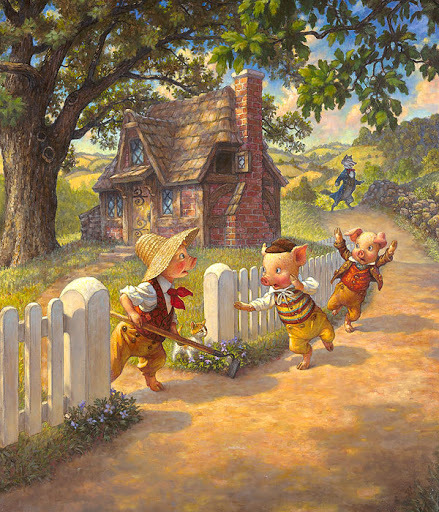

The 1933 Disney version
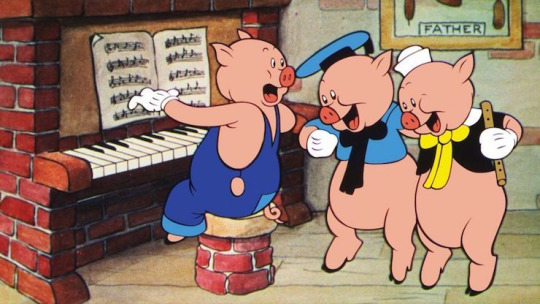
The Fairy Tale Theater version

The Triplets version

The Shrek version

#fairy tales#fantasy#genre fiction#the three little pigs#tumblr mutuals#princesssarisa#ask game#tag game#replied#answered#fictional characters#character ask meme#fictional character ask#literature#pop culture#mithology#folklore#folk tales
14 notes
·
View notes
Text
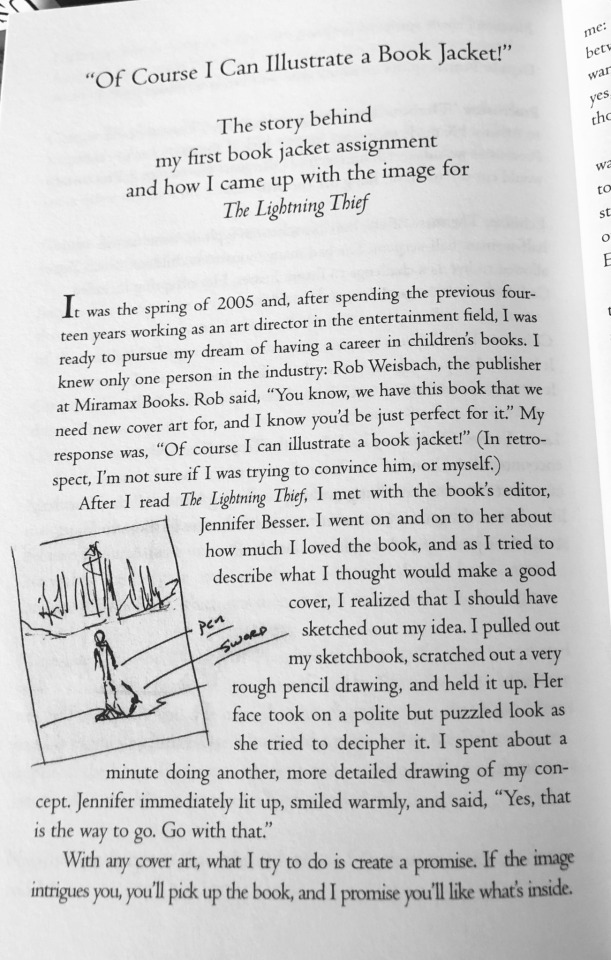


"Of Course I Can Illustrate a Book Jacket" by John Rocco, from the 10th anniversary edition of The Lightning Thief, 2015
(text version for readability under the cut)
image 1: "Of Course I Can Illustrate a Book Jacket!"
The story behind my first book jacket assignment and how I came up with the image for The Lightning Thief
It was the spring of 2005 and, after spending the previous fourteen years working as an art director in an entertainment field, I was ready to pursue my dream of having a career in children's books. I knew only one person in the industry: Rob Weisbach, the publisher at Miramax Books. Rob said, "You know, we have this book that we need new cover art for, and I know you'd be just perfect for it." My response was, "Of course I can illustrate a book jacket!" (In retrospect, I'm not sure if I was trying to convince him, or myself.)
After I read The Lightning Thief, I met with the book's editor, Jennifer Besser. I went on and on to her about how much I loved the book, and as I tried to describe what I thought would make a good cover, I realized that I should have sketched out my idea. I pulled out my sketchbook, scratched out a very rough pencil drawing, and held it up. Her face took on a polite but puzzled look as she tried to decipher it. I spent about a minute doing another, more detailed drawing of my concept. Jennifer immediately lit up, smiled warmly, and said, "Yes, that is the way to go. Go with that."
[To the left is a photocopy of his sketch, which features the figure of a boy holding a pen. He is standing in water and the reflection of his pen in the water is a sword. There are tall skyscraper buildings in the background.]
With any cover art, what I try to do is create a promise. If the image intrigues you, you'll pick up the book, and I promise you'll like what's inside.
image 2: When I first read The Lightning Thief, this is what stood out for me: it's the story of a kid who is stuck in the middle of an argument between two adults, and he feels helpless and alone. That's what I wanted to show. Sure, those two adults were Zeus and Poseidon, and yes, the argument was over a seven zillion-watt lightning bolt, but those details would inform the imagery, not overwhelm it.
So I knew I was going to have Percy alone on the cover. I didn't want to actually show Zeus and Poseidon, so I thought the best way to represent them would be with a stormy sea (Poseidon) and a stormy sky (Zeus). I chose to put Percy in the water, as he is the son of Poseidon, staring at the New York City skyline-- in particular, the Empire State Building.
A lot of people ask me why I have Percy with his back to us on the cover. I did that for two reasons. First, when I'm reading a book and the main character's face is clearly visible on the cover, I can no longer make up my own ideas about that character. There is no room for my imagination. If I don't see his face, he could be anybody. He could even be me! I love books that make me feel like the hero of the story. Second, with Percy facing away from us, we, as readers, are on the adventure with him, following him into the book.
[To the right is a more detailed version of the sketch from image 1. On the top half of the drawing, there are strikes of lightning in the air and a storm cloud hovering over a city with many skyscrapers. The silhouette of the Empire State Building is in the middle of the city. The bottom half of the drawing is an ocean, in which a boy is standing with his back to the audience. He holds a sword in his right hand and faces the city skyline.]
Others might ask: why didn't you put any mythological imagery on the cover? Honestly, I felt it wasn't necessary. There are so many books already out there about Greek myths, and I didn't want it to be one of those "Here's a great adventure book and you're also going to learn something along the way!" That's kind of a turn-off for me. Also, the Greek mythology connection is inherent in the series title: Percy Jackson and the Olympians.
image 3: I had figured out that I wanted to show a young boy standing in a raging sea with a massive storm overhead, with the New York City skyline in the background, lit up by lightning. How was I going to make this faceless boy stand out with all of that going on? With color. I knew Percy's shirt was going to be orange, because that's the color of the Camp Half-Blood T-shirt. So, in order to make him "pop" from the background, I chose to use a complementary color everywhere else. On the color wheel, the opposite of the red-orange of Percy's shirt is blue-green. Percy would be the only warm thing on the cover; the rest would be very cool. When there is something warm in a painting, it always tends to "come forward," and the cooler colors tend to recede. As an illustrator I use this tool to give my paintings depth.
The Lightning Thief was only one of the many covers I have illustrated for Rick Riordan's books. I even reillustrated my own covers for Percy Jackson! My new art for the series, which creates a mural when the books are placed side-by-side, was unveiled in 2014. But the original Lightning Thief cover will always hold a special place in my heart, because not only was it for the first book in a phenomenal series, but it was also my first-ever cover art. I'm proud that it has become associated with a classic piece of children's literature.
Happy anniversary, Percy!
John Rocco
#john rocco#pjo#blah blah blah#as i was saying before..... john deserves his rights#let me know if i need to edit anything in the text version!#100
250 notes
·
View notes
Text
Ready Player Two: The Mysognist’s Love Song
This is a review. Spoilers & typos to follow:
I enjoyed Ready Player One (RP1). It was quirky and fun. The dystopian setting was disturbing, especially as the kid who served as the story’s protagonist didn’t actually do much to make the world a better place, once he became its newest prince. We’re told from the git-go that the world is spiraling downhill, and what does Wade/Parzival do at the end? The bare minimum. He lets the debtors go. He shares his riches with his friends. Well, he was literally just a teenager, and most assuredly a feral one, at that, so you could excuse his lack of vision. Certainly there would be a Ready Player Two (RP2) that would redeem our child champion?
Haha, no.
RP2 is the story of what happens to a neglected impoverished child when he lucks into immense privilege, but lacks the heart, charm, or charisma to be anything other than a hermit and an incel. Where Harry Potter could arguably be said to have started from a similar circumstance, yet grew into an actual savior role in his fight against Voldemort & the Death Eaters, Wade Watts’ character in RP2 is unabashedly a less-loveable version of Donald Trump in a world where he is, in all practicality, king.
As RP2 begins, Wade owns everything. Not just the Oasis, but a futuristic tech that allows one to record their own visceral experience of being alive. This tech, called ONI, goes even more viral than the Oasis, and makes Wade rich beyond the human mind’s ability to calculate. He has power--so much power, he can control anything. He is literally the richest man in the world, and most assuredly its most envied/hated. Nothing is out of reach for him--and though his friends from RP1′s ‘Gunting days are portrayed focusing on developing real relationships (marriages, babies, etc.), working on improving their environments, and delivering aid to their communities, our dear Wade simply pines for the one thing that eludes him: Samantha, aka Artemis, his fierce and determined love interest from RP1.
He brags about the one week he spent in seclusion with Samantha in a bedroom. He talks way too often of his other sexual exploits via ONI, allowing him to experience sex from the POV of other men, women, transpeople, and non-binary folks. He has done the deed every which way but loose, and author Ernest Cline is as eager to share those details with the reader as he is the spout off acronyms and descriptions of fictional technology. Whereas the latter will have you yawning in boredom, the former will simply turn your stomach. Raise your hands if you were hoping for more cybersex in RP2. Anyone? Anyone? Right.
Before I delve too deeply in how important it is for even blockbuster authors like Cline to CONSENT TO QUALITY EDITORIAL INPUT, I need to outline some important problems with this story beyond “What’s wrong with Wade, items 1-999.”
Samantha is justly described to have turned her back on Wade over some important issues. She is a woman of integrity, and for years Wade stalks her virtually, even though in all reality he grows a smaller and smaller figure from her past. Think about any woman you know who moves on and gets things done in life: they do not sit around pining for a dickhead ex who they slept with once, years prior. They just don’t. Samantha, however, despite all her success, integrity, and morals...just can’t help but fall back in love with Wade.
All powerful Wade. Involuntarily celibate (in the “Earl,” as Cline calls “in real life,” [IRL]), plugged into the internet from his spinal column or brain stem or whatever, 12 hours per day Wade. Childish destroyer of dissenting user accounts Wade. Stalker Wade.
Although Samantha refuses to make eye contact with him for years, the moment he needs her help...poof. She’s back on his jock like static cling, if I may borrow Cline’s penchant for quoting nostalgia in lieu of creating new content.
While Samantha’s inexplicable change of heart is problematic enough, it is only foreshadowing for a bigger problem with the story. Wade, as owner of the Oasis and all that digital shit, ends up on a quest to restore the Siren’s Soul. This is the “egg hunt” of RP2. Instead of eggs, this time he’s hunting shards, which is fitting, really, because Cline left me feeling sharted on by earlier than midway through the text.
Where were we? The shards. Right.
The singular essence of Kira Underwood, constantly referred to as “Og’s wife,” has been divided into seven shards and hidden around the Oasis--that is, until the end of the story when Cline mercifully hid the last two together. I might have wept if the story had gone on one chapter longer than necessary. When the shards are collected and merged, they will...? What? Oh, they will coalesce into the actual soul of the departed woman. They will bring her back, digitally.
Now, not only is it creepy on many levels that Wade--let’s call him Parzincel--is repeatedly referred to as Kira’s owner, but his idol before him, James Halliday, is characterized has having created this ONI technology for the main purpose of bringing Kira back, so that a digital version of himself could finally possess her. While “thou shalt not covet thy neighbor’s wife,” is certainly a handy commandment, “thou shalt treat women as FUCKING PEOPLE WITH THEIR OWN INHERENT RIGHTS” would perhaps be a better placard to engrave and set on the desk of Halliday--to then be passed down to Wade. It never seems to dawn on Parzincel that he has no right to possess Kira, or any other ONI user.
The in-game avatar of Halliday eventually explains that Kira’s “siren” avatar was able to explain to him that possessing her, manipulating her, etc. was wrong--but ONLY after Halliday hooks himself up the ONI and lives some of Kira’s experiences. Cline plays Halliday off in both books as an Aspergian genius, someone very high functioning on the Autism Spectrum, but as the mother of a young man with autism, I am beyond disgusted at the idea that you would have to hook one living being up to another human being’s synapses for them to have ANY understanding that the other person is a free, competent human being with agency of her own. Kira is repeatedly characterized as an artistic genius with a great heart. She, like Samantha, is demonstrated to be loving and kind. Generous. And yet both Kira and Samantha are primarily belongings for men to possess, control, pursue, and lose. Oh, if only they did lose them...because of course, they don’t. In Parzincel’s dream future, the best thing he can do is create a double of himself, so that he can experience the inexplicable love of Samantha in the “Earl” as well as in an ONI paradise.
Kira, as the “first stable AI,” is never once shown having any sort of existential crisis. She simply loves being a pretty plaything for Wade and Jim and Og, digitally--and naturally she is “still in love with Og.” Okay, whatever. By this point in the story, Og and Kira are nothing more than paper dolls set up to somehow replace Wade’s missing mother/father figures. You can almost see the author sitting spraddle leg on the floor of his study, pushing dolls around. “You are the mommy now, and you are the daddy...and Wade is the baby! Now kiss!”
In a world as technologically advanced as that of RP2, there would be nuances to digital characters, right? If only there were nuances in the humans who created them, I suppose.
Cline’s Parzincel has a weird weird weird way of looking at women. So does Halliday. Even the benevolent Og only barely registers as showing any interest in Kira’s consent, and then, only when he is, himself, close to death. It’s like Cline knew the only decent human being in this story was Ogden Morrow--and possibly Kira. We don’t really get to spend enough time with the Kira character to know.
But why would we? We are just readers, and she is, after all, Og’s wife.
I won’t get started on the Lo-Five or what he did to Aech. I’ll let Tim take over for that bit.
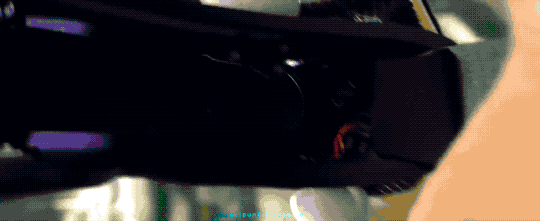
8 notes
·
View notes
Note
I think you're approaching the Velvet engineering thing from the wrong direction. Rather than "she's a genius weapon maker" leading to "she can fix the relay", it's "she's a genius technician" which in turn led to her making her weapon, and also fixing the relay. BTD describes her as having invented multiple things, in a way that makes it seem like it was her hobby before Beacon. It's like how you could take Pietro to the relay and he could probably fix it too; it's simple relative to his work.
That’s fair, though I’m personally still meh about such broad skillsets. Which, I want to emphasize, isn’t the end of the (writing) world. As mentioned in the recap, it’s pretty common to have a character who is just Good At [Thing] and therefore they’re available to do whatever the plot needs. One of the reasons why I think that archetype works in other stories though is because they’re defined only - or at least majorly by - that skill. Again, think the computer person who lives and breathes tech. It’s their job, it’s their hobby, it’s their life. Someone like Garcia from Criminal Minds. So when the story suddenly tells you they can do something, it’s a little easier to swallow because you know they’re practicing at least a version of this skill 24/7. That’s why Pietro works better for me too. He’s a scientist and... that’s pretty much the only thing we know about him. Ironwood’s scientist, Watts’ scientific rival, dad to the unique science experiment, the scientist who knows Maria because he fixes her glasses, ally to the team because he provides them with tech - his character is 100% built around being Good At Science, making the broadness of it easier to accept (even if the show could still benefit from asking questions like, “Would the guy focusing on aura experiments really know how to launch Amity Tower?”). Velvet, on the other hand, isn’t shown doing much tech stuff. We’re told she made her weapon... but so did everyone at Signal. We’re told she’s invented things, but (in this novel so far) we don’t see her working on them, studying them, thinking about them, etc. She’s not an Izuku who is constantly immersed in her talent, in his case journaling, muttering about, and strategizing during fights to forward his skill of analyzing heroes. We’re then told that Velvet can fix relays... but she kind of fails to fix the relay... kicks the relay... now it’s fine... so what did she do exactly? Was it her skill that fixed it, or did sand just cause problems and she knocked it loose? The broadness of that skill combines with an uncertainty about what (if anything) Velvet accomplished here, leaves her talent up for debate.
And I do think the broadness itself can be improved upon. Again, it’s not a make or break issue here - I’m arguably nitpicking - it’s just another way to think about your characters and ways to make them feel real and relatable. If I write a Witcher fic where someone hands Jaskier a flute, my first instinct is not to write that he plays it beautifully because his skill is “good at music.” That’s not actually a skill because “music” as a subject is composed of so many different things. What Jaskier is actually good at is composing songs, singing, and playing the lute. So if he’s given a flute you could have him play it beautifully while tossing out a line about where/when he learned that additional skill. Or you could have him play the flute not great, but better than someone who had no knowledge of music whatsoever. Or you could have a horrible screech emerge and when other characters look surprised Jaskier is like, “What? I’ve played the lute for the last twenty years. What made you think I’d ever even picked up a wind instrument?” But the idea that Jaskier as someone who is a “genius with music” could play absolutely any instrument is... unpersuasive. As is saying someone who is a genius at tech could understand/fix any tech-related thing you put in front of them. It’s a lackluster form of characterization and it eliminates the potential for a scene that ends in something other than success. It’s also just less realistic (if we care about such things, admittedly). I’m really good at crafts, but years ago that wouldn’t have helped me much if you had handed me a crochet hook instead of knitting needles. I still needed to learn how to chain first. Being really good at a subject usually means you have a foundation to learn other skills more easily, not that you magically know what those skills are. If Velvet has never examined relays before, she should have very little idea - if any - of what to do with them.
That’s basically how I’d revise her skill then. Maybe her team expects her to fix the relay and she’s like, “Wtf? Why would I know that? I’ve been specializing in hard light mechanics for the last four years...” Or we see Velvet studying the communication towers after the Fall of Beacon, hoping to assist in fixing the CCT someday, and her new knowledge becomes useful on this mission. Or, at the very least, we see her immersed in her genius skillset to the point where we accept that Velvet is the character archetype who can do anything related to her field when necessary. As it is though, Velvet will comment in the next chapter that she’s so swamped she forgot to meet up with Sun and Neptune. She doesn’t have the time to be studying these additional skills and we haven’t seen it much, only heard about it in the past.
I’d have the same issue if RWBY pulled this with Ruby. If we were told she’s this genius who created “one of the most dangerous weapons every designed,” covered five volumes where that genius was only acknowledged once in a blue moon, and then in Volume 6 Ruby went, “Why would we need Terra’s help to shut down the military base’s communication? I’m a genius technician, remember?” The fact that the episode had an insider provide that expertise is a good thing, the sort of detail Myers’ scene would have benefited from. Just have the technician still conscious, walking Velvet through the repairs because she has that foundation to better understand what he’s telling her. There are lots of ways to showcase a character’s skill without making the reader go, “Wait... really?”
10 notes
·
View notes
Text
America's First Black Physician Sought to Heal a Nation's Persistent Illness
https://sciencespies.com/history/americas-first-black-physician-sought-to-heal-a-nations-persistent-illness/
America's First Black Physician Sought to Heal a Nation's Persistent Illness
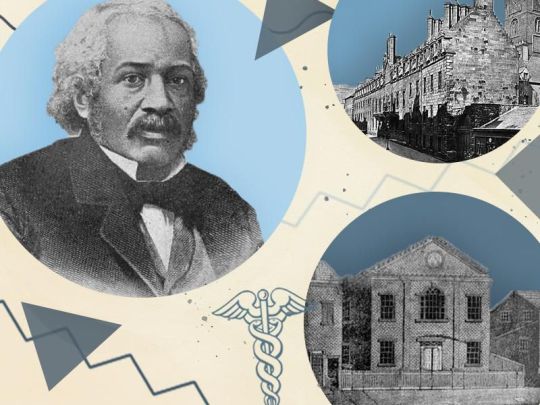
James McCune Smith was not just any physician. He was the first African American to earn a medical degree, educated at the University of Glasgow in the 1830s, when no American university would admit him. For this groundbreaking achievement alone, Smith warrants greater appreciation.
But Smith was also one of the nation’s leading abolitionists. In 1859, Frederick Douglass declared, “No man in this country more thoroughly understands the whole struggle between freedom and slavery than does Dr. Smith, and his heart is as broad as his understanding.” A prolific writer, Smith was not only the first African American to publish peer-reviewed articles in medical journals; he also wrote essays and gave lectures refuting pseudoscientific claims of black inferiority and forecast the transformational impact African Americans were destined to make on world culture.
John Stauffer, a Harvard English professor who edited The Works of James McCune Smith, says that Smith is one of the underappreciated literary lights of the 19th century, calling him “one of the best-read people that I’ve encountered.”
“The closest equivalent I really can say about [him] as a writer is [Herman] Melville,” adds Stauffer. “The subtlety and the intricacy and the nuance…and what he reveals about life and culture and society are truly extraordinary. Every sentence contains a huge amount.”
Smith was born enslaved in New York City, in 1813, to Lavinia Smith, a woman born in Charleston, South Carolina, who historians believe was brought to New York in bondage. While James McCune Smith never knew his father, a white man, university records indicate he was a merchant named Samuel Smith. (Amy Cools, a University of Edinburgh scholar who has conducted the most extensive research into Smith’s paternity, maintains, however, “Meticulous research has thus far failed to yield any records of [such] a Samuel Smith…indicating the name “Samuel” may possibly have been entered into [the] university records for convenience or respectability’s sake.”). Smith received his primary education at the African Free School #2 on Lower Manhattan’s Mulberry Street, an institution founded in 1787 by governing New York elites. Their aim was to prepare free and enslaved blacks “to the end that they may become good and useful Citizens of the State,” once the state granted full emancipation.
The school graduated a roster of boys who would fill the upper ranks of black intellectual and public life. Smith’s cohort alone included Ira Aldridge, the Shakespearean tragedian and first black actor to play Othello on the London stage; the abolitionist minister Henry Highland Garnet, the first African American to address Congress; Alexander Crummell, an early pan-Africanist minister and inspiration to W.E.B. DuBois; and brothers Charles and Patrick Reason, the first African American to teach at a largely white college and a renowned illustrator-engraver, respectively. These men’s achievements would be exceptional by any standard, but even more so, for a group who were born enslaved or deprived basic rights as free blacks.
They were also all leading abolitionists, contributing their varied talents to the cause. University of Connecticut literature professor Anna Mae Duane, who tells the intertwined life stories of Smith and his classmate Garnet in her book Educated for Freedom, says the boys at the African Free School spurred each other on to great success and that the school’s innovative method of teaching contributed to that. The schoolmaster, a white Englishman named Charles C. Andrews, brought with him from his home country the Lancasterian system to help one or a handful of teachers instruct a class of 500 boys. “The boys would teach other,” Duane says. “They were all deputized as assistant teachers, basically.” This had a galvanizing effect on their confidence.
“When you are learning something, you are learning from another black person,” Duane says. “There was so much they did for each other because of way the school was run. It gave this incredible sense of authority and community.” Just as they elevated each other, the boys were destined to do the same for their people. Garnet formed a club of among the boys, Duane says, and the boys took an oath to “get their education and free everyone down south.”
Even among this exceptional group, Smith stood out as the school’s star pupil. In 1824, the school selected him to address the Marquis de Lafayette when the abolitionist Revolutionary War hero visited the school during his farewell tour of America. Freed by New York’s Emancipation Act of 1827, and after graduating the African Free School at 15, with honors, the next year, Smith apprenticed to a blacksmith, while continuing his studies with area ministers.
He took instruction in Latin and Greek from his mentor, the Reverend Peter Williams, Jr., another African Free School alum, and the pastor of St. Philip’s Church, the leading black church in the city. Garnet recalls his friend working “at a forge with a bellows in one hand and a Latin grammar in the other.” In time, Smith would master French, and demonstrate proficiency in Spanish, German, Italian and Hebrew.
When Columbia University and Geneva College (now Hobart and William Smith Colleges in New York) refused Smith admission because of his race, Smith’s benefactors raised funds so he could attend the University of Glasgow, which Stauffer describes as “a deeply abolitionist university at the time,” with ties to the abolitionist movement in New York. “Glasgow was a far better university than any American college at the time,” Stauffer said, and “on par with Oxford and Cambridge.” The university had been the seat of the Scottish Enlightenment just decades earlier, and had graduated pioneering thinkers including Adam Smith and James Watt.
At Glasgow, Smith was a charter member of in the Glasgow Emancipation Society, joining just before Britain abolished slavery in 1833. In a span of five years, he earned his bachelors, masters,’ and medical degrees, graduating at or near top of his class. Then, he completed his residency in Paris. The African American press heralded his return to the U.S. in 1837.
In New York, Smith established his medical practice at 55 West Broadway, where he also opened the first black-owned pharmacy in the United States. He saw both black and white patients, men and women. “[Whites] were willing to go to him because of his reputation,” Stauffer says. “He was widely recognized as one of the leading medical doctors in New York.…Even white doctors who were racists couldn’t help [but respect his expertise] because of his publications.” In 1840, Smith authored the first medical case report by an African American, titled, “Case of ptyalism with fatal termination,” but was denied the opportunity to present this paper on fatal tongue-swelling to the New York Medical and Surgical Society, “lest it might interfere with the ‘harmony’ of the young institution,” the society insisted. His paper, “On the Influence of Opium upon the Catamenial Functions,” was the first publication by an African American in a peer-reviewed medical journal.
While the foregoing represents Smith’s contributions to conventional medical research and treatment (and concerned mostly white patients), Smith dedicated considerable attention to challenging pseudoscientific justifications for African American oppression. The moment he stepped back on U.S. soil, he delivered a lecture titled “The Fallacy of Phrenology,” where he attacked the notion that head shape and size dictates the relative intelligence of different racial groups.
Having embraced at Glasgow Adolphe Quetelet’s pioneering application of statistics to social science, Smith frequently marshaled sophisticated statistical analysis to make his case. When the federal government used data from the 1840 census to argue that emancipated blacks in the North, when compared to those still enslaved, were “more prone to vice and pauperism, accompanied by the bodily and mental inflictions incident thereto—deafness, blindness, insanity and idiocy,” Smith mounted a campaign to refute the claim.
The Harvard-trained physician Edward Jarvis, who had initially supported these government findings, later joined Smith in exposing fundamental errors in the census. For example, Smith demonstrated that the census often tallied more infirm or “insane” black persons than there were black persons in a given state (“to make 19 crazy men out of one man”). More fundamentally, he showed the census failed to account for the higher mortality rate among the enslaved population—the murder of blacks, he charged, at young ages. In an 1844 letter to the New York Herald on the topic, he writes, “What mockery it is for men to talk of the kindness of masters in taking care of aged slaves, when Death has relieved them of so large a share of the burden!”
Smith served for 20 years as the medical director of the Colored Orphan Asylum, a position he assumed some years after he accused the asylum’s previous doctor of negligence for concluding that the deaths among his charges were due to the “peculiar constitution and condition of the colored race.” Smith made great improvements in the medical care at the institution, containing outbreaks of contagious diseases by expanding the medical ward to allow for greater separation and isolation of sick children. He saw the Quaker-run institution as one of the best schools in the city for black children, providing for them what the African Free School provided for him, with a critical difference: Duane says the philosophy of the African Free School was, “You need to admire a version of history that disconnects you from the history of slavery in this country…your own mother… You’re not orphaned but you orphan yourself. You leave the past behind.”
The leaders of the African Free School contemplated the children would educate themselves, gain freedom and repatriate to Africa. By contrast, Smith, says Duane, “saw education [at the orphanage] as a way of supporting families, of putting down roots in the U.S. And fighting for citizenship.”
He also knew an educated black population marked the beginning of the end of slavery. Slavery, Stauffer says, relies on a “totalitarian state” where no one is permitted to question the status quo. So, in the case of enslaved persons like Smith and his cohort who become free, he says, “That’s when they start speaking and writing profusely, and that’s what really fuels or creates the abolition movement.” Education and freedom of expression is anathema to slavery. “All slave societies do their best to prevent slaves from having a public voice, because if they do it’s going to wreak havoc on the society.”
Havoc was necessary if abolition could not be achieved by other means. Smith defied the 1850 Fugitive Slave Act, which required that citizens in free States aid in the recapture of persons fleeing bondage, as he met with other black activists in the back room of his pharmacy to arrange for the protection of runaways. In 1855, he co-founded the interracial Radical Abolitionist Party, with Frederick Douglass, former Congressman Gerrit Smith, and John Brown, the abolitionist man-in-the-arena, who in 1859 would lead a foiled attack on the federal armory at Harper’s Ferry, Virginia, in an attempt to instigate a revolt among the area’s enslaved population. The party advocated a pluralistic, egalitarian society, for men and women of all backgrounds.
Unlike William Lloyd Garrison advocated “moral suasion” as the means to rid the nation of slavery, these radical abolitionists were prepared to use violence if it would liberate their brethren from bondage. Smith reasoned in an 1856 essay in Frederick Douglass’ Paper, “Our white brethren cannot understand us unless we speak to them in their own language; they recognize only the philosophy of force. They will never recognize our manhood until we knock them down a time or two; they will then hug us as men and brethren.”
Smith predicted the institution of slavery would not give up the ghost on its own. “African Americans recognized that violence is at the heart of slavery,” Stauffer says. “Without violence, slavery cannot exist…And so, [African Americans] were practical.”
In general, Smith and the Radical Abolitionist Party believed that white Americans needed to embrace African-American perspectives in order to see America in its true light and redeem it. He wrote, “[W]e are destined to spread over our common country the holy influences of principles, the glorious light of Truth.” This access to truth, he predicted, would be manifested in African American oratory, poetry, literature, music and art. Stauffer says that one of Smith’s lifelong interests was to reveal to people the unrecognized influence of Africans and African Americans in the advance of scholarship and culture. An 1843 publication records Smith proclaiming in an 1841 lecture:
“For we are destined to write the literature of this republic, which is still, in letters, a mere province of Great Britain. We have already, even from the depths of slavery, furnished the only music this country has yet produced. We are also destined to write the poetry of the nation; for as real poetry gushes forth from minds embued with a lofty perception of the truth, so our faculties, enlarged in the intellectual struggle for liberty, will necessarily become fired with glimpses at the glorious and the true, and will weave their inspiration into song.”
Indeed, as Smith observed, songs among the enslaved were already shaping American music in his time. “Sometimes I Feel Like a Motherless Child,” a haunting spiritual about the separation of children from their mothers during slavery, would later, as musicologists acknowledge, form the basis for George Gershwin’s 1934 song, “Summertime.”
Smith himself made significant contributions to the American literary canon with a series of narrative sketches in Frederick Douglass’ Paper, which he called, “The Heads of Colored People.” With its title mocking the attempts of phrenology to diminish the worth of African Americans, Smith paints dignified portraits of everyday black people—a bootblack, a washerman—as examples of the unique personalities inherent to every human being.
Smith died in November 1865 of congestive heart failure, living his final years in Williamsburg, Brooklyn. He and many black families fled Manhattan after the 1863 Draft Riots, where largely working-class Irish draft resisters assaulted and killed black New Yorkers and attacked charitable institutions associated with African-Americans and the war. Most distressing for Smith were these events of July 13 of that year, as reported by the New York Times:
“The Orphan Asylum for Colored Children was visited by the mob about 4 o’clock. … Hundreds, and perhaps thousands of the rioters, the majority of whom were women and children, entered the premises, and in the most excited and violent manner they ransacked and plundered the building from cellar to garret.”
The rioters burned the building to the ground. Fortunately, the staff managed to escort all the children to safety through a back exit. An ailing Smith was not at the asylum that day, and despite attacks in the vicinity of his home and pharmacy was not harmed. But he and other black New Yorkers were shaken. The mob ultimately killed an estimated 175 people, including many who were hanged or burned alive. It’s estimated that in the riot’s aftermath, Manhattan’s black population declined by 20 percent, many departing for Brooklyn.
“I didn’t know he was my ancestor,” says Greta Blau, a white woman who learned about Smith when she wrote a paper on the Colored Orphan Asylum for a class at Hunter College in the 1990s. While she had seen his name in her grandmother’s family Bible, he was a “Scottish doctor” in family lore. Only later did she make the connection. “I think all his children “passed,” she said, meaning that Smith’s descendants hid their black ancestry in order to enjoy the privileges of whites in a segregated world. The 1870 U.S. census recorded Smith’s children as white and they, in turn, married white spouses.
Knowledge of Smith’s achievements as an African American might have endured had he published books, but his essays from periodicals were more easily forgotten. Whereas Douglass was the most photographed American of the 19th century, only one portrait of Smith exists. Blau realizes why Smith’s children did not seek to keep his legacy alive: “In order for his children to be safe and pass, he had to be forgotten,…which is tragic.” In 2010, Blau arranged for the placement of a new headstone at Smith’s grave in Brooklyn’s Cypress Hill Cemetery.
Remarkably, several white descendants of Smith are interred in the same section established by St. Philip’s Church, the black church Smith attended. Blau’s grandmother, who died in 2019 at 99 years old, joined her for the ceremony at the gravesite, as did descendants from Smith’s other children, whom Blau first met when she contacted them to share the news of their ancestor. While other descendants she contacted did not welcome the news of her discovery, these distant cousins who joined her for the ceremony made the journey from the Midwest to be there. “They were proud of it. Just proud.”
#History
3 notes
·
View notes